#I post these purely out of my own enjoyment (hence them always being posted in dead times) and it's so nice to see people get happy about
Text
Genuine
"Sherlock," John locked eyes with the detective,"you are bloody gorgeous."
A very prominent blush crept up the other's neck,"I-I erm…"
"And adorable, look at that,"He leaned forward and smiled. John knew for a fact that he was one of the few people who existed that could actually catch him off guard, and by god this had to be the best way to get those gears in the detective’s head to stop.
Sherlock broke eye contact and tapped nervously on the table,"You're getting too direct with your flirting."
"So you've noticed?"
He nodded and looked around the room, still refusing to look at John,"So- uh, what,” Sherlock cleared his throat, the telltale signs of embarrassment peeking through,”what brought this up?"
"It's just been eating me up for a bit,"He propped his head up on his hands,"And I'd… I’d like to kiss you."
Those few words caused Sherlock's entire system to malfunction, a small sound of shock barely escaped his lips. For a moment, John found it rather endearing that his friend was an actual blushing virgin, but as soon as the spell broke, he wondered what the consultant's response would be,"Me..?"
"Yes, you."
"I have to confess that I do not possess much experience in this area-"
What had once been a quiet morning in the kitchen of 221b ultimately transformed into… this. Not that either of them were complaining, they were finally clearing the tension that held strong between them for years, however… jolting it felt.
"You're a fast learner," His tongue swiped along his bottom lip,"I don't think it would take long for you to pick it up."
"Is that an offer to teach me, Dr. Watson?" he whispered, not trusting himself to keep a steady stream of words in his current state. Said “state” could be summed up as "confused, turned on, and extremely giddy".
The quiet flirt back made John more than happy,"Of course, I'll even do it for free 'cause you're being so cute about it."
The detective huffed, crossing his arms and slumping in his seat,"I am not cute."
"You're proving my point right now. Pouting with those sinful lips of yours."
"I-" at this point, his mind may as well be fried because it felt absolutely useless. Not a single deduction could be made by John's smiling face, only the word 'mine' over and over,"I-I give you… permission."
"Permission?"
"Yes," with a bit more confidence,"I know you're a man of morals, and you wouldn't do anything without explicit consent- so I consent to you."
John stood, making sure not to move too fast, he didn’t want to frighten Sherlock in this exposed mindset,"And you are aware that you can take that consent away at any time?"
A slight nod,"I know."
"Alright," He brought a hand to cup Sherlock's jaw, lifting his thumb to run across his bottom lip,"I have watched these lips for years," John dipped his head down a bit, milimetres away from Sherlock's face,"I always wondered how they would feel on mine."
"Care to find out?" his breath ghosting along John's skin.
"God yes."
Sherlock closed the small gap, lips barely pressed together. It was his first time being so close to someone he loved, and understanding that this was all new to Sherlock, John let him control the pace. It was soft, tentative, tender, they reveled in the intimate contact. They had been craving this for years, and now here they were. The spark that had lingered became a roaring fire, all from a small, genuine kiss.
After a moment, John pulled back, realising that the detective had ceased all effort to function,”Breathe.”
His eyes remained closed as he sucked in a lungful of air,”More please,” Sherlock blinked a few times before sending John the most desperate look he could muster.
“How could I say no to my brilliant detective?”
@helloliriels @fluffbyday-smutbynight @emaster875 @dinner--starving @loki-lock @kettykika78 @mycrofts-umbrella-in-the-tardis @gaylilsherlock @topsyturvy-turtely @colourfulwatson @safedistancefrombeingsmart @kyramaximoff @psychosociogentleman @peanitbear @astudyin221b @justanobsessedpan @thesherlockandjohnshow @icatee @boldlygowhereitsbiggerinside @whatnext2020 @forfucksakejohn
Lemme know if you wanna be taken off the tag list!! And definitely let me know if you wanna be added!
I finally got round to making an actual list for my lil random fics, so please please let me know if you wanna be added/removed because I don't wanna be a pain-
#johnlock ficlet#mini fic#bbc sherlock#johnlock#john watson#sherlock holmes#sherlock fanfiction#fanfiction#original fanfiction#I love doing these lil moments where they're like:#I like you#I like you too#omg really?#because they're so damn oblivious about each other and I'm over here yelling#''JUST FUCKING KISS''#so here is my contribution#also I would like you all (who have been reading. liking. and or reblogging) to know that I am so happy you enjoy my writing!!#I post these purely out of my own enjoyment (hence them always being posted in dead times) and it's so nice to see people get happy about#them#yes#I LOVE YOU GUYS#musings masterpiece#the truest masterpiece of all time
255 notes
·
View notes
Link
So I finally posted my Franklin/Nubbins fanfiction, lol. Shout out to the three or so people who might enjoy it, I just had fun writing, even if I’m not confident! I wasn’t so sure about tagging, but there are allusions to violence and animal death, the kind you’d see in the movie.
70 notes
·
View notes
Note
How do you feel about the sudden shift in pacing in SUF? Personally, I was so disconcerted at first, I thought that it was /worse/ than the original series, then I rewatched, and realized that it was just really different. It's definitely a lot more blunt in the humor, and of course there's the whole Steven-not-knowing-everything-anymore-thing. What do you think?
The overall pacing of Steven Universe Future has been very enjoyable!
I genuinely find it to be pretty damn good actually, as its focus is crystal clear on where it should be. That being Steven Universe’s inner dilemma of what he’s supposed to do now the whole massive conflict with the Diamonds has been solved. As much as I loved Steven Universe’s story when it focused on the main conflict surrounding the Crystal Gems against their own planet and learning more about each of them, along with Rose’s entire backstory too, it still suffered from some of the Beach City episodes dragging it down in the pacing when it could’ve focused more on the other characters, like further exploring Lapis and Peridot’s chemistry for example. That isn’t to say I hated every single one, as some were actually enjoyable and gave me an appreciation for them in a sense. Sometimes it’s okay to take a breather and have a simple slice of life episode. Fun fact, I didn’t get into watching the OG series, until the movie was released last year, so that gave me more of a tolerance for the Beach City episodes. Makes me very glad that I waited this long because hoo boi some of the hiatus issues I’ve heard about from a close friend of mine, who got into watching this series when it first aired back then, weren’t pretty. LMAO!
Anyways, the idea surrounding Steven’s characterization of not-knowing-everything-anymore-thing, as you’ve put it, isn’t actually as weird, from I’ve heard some people make it out to be for a form of criticism that people on Tumblr have made rebuttals against before. It’s wonderfully consistent with what Steven’s character is all about and that’s trying to figure out his place in the world. This has always been a consistent struggle for himself, like the lyric mentioned in the full version of the series opening from Steven.

“I will fight to be everything that everybody wants me to be when I’m grown!”
Steven’s whole internal conflict surrounds not knowing whether or not he can exactly be like his mother, which puts a shit ton of insecurities on his own self-worth into trying to fit in with the other Crystal Gems because he’s not your average-every-day-kid that you see in society. He’s a special hybrid of human/gem that neither side of the species connected to him has ever seen before and that puts a ton of pressure onto how the boy feels a need to connect with both sides of himself. While he already has a deeply loving relationship with his father, Greg, Steven also wants to better understand that Gem lineage and why his mother was so revered by what he perceives to be these amazing warriors, who fight evil. Never mind putting this onto a kid’s existence, as soon as he or she’s brought into reality, but even an adult would struggle a lot with all this stuff. As the original story progressed, Steven learns all of the hardships the Crystal Gems faced many centuries ago and what his own mother did to protect the Earth in exchange for many issues Steven would have to handle, as soon as Pink Diamond gave up herself to create the child.
Holy shit, did he ever have to handle the baggage from Pink Diamond.
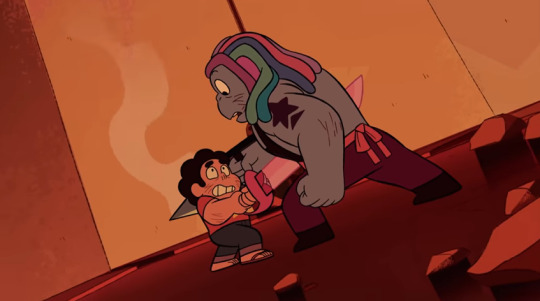

You should’ve shattered me back then. At least if I were in pieces, I wouldn’t have to know how little I mattered to you. You didn’t even tell em. You bubbled me away and didn’t ever tell your friends! MY friends!

I’m going to tell them. I’m gonna tell them everything.
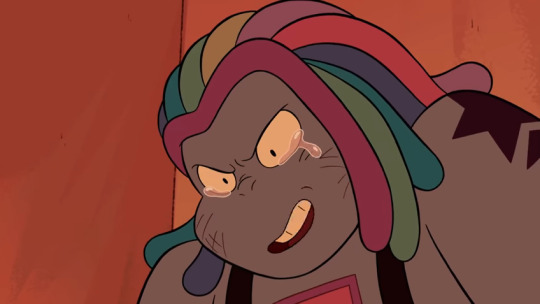
Then you really are better than HER…
Pivotal moments, like in the episode centered around Bismuth, paint everything in an entirely different light for Steve’s ideals based around his mother. At first, Rose Quartz was implied to be an individual who could do no wrong to any living thing, but hindsight from Bismuth’s trauma paints everything in an entirely different light for this poor boy having to take on the entire blunt of this figurative dagger. A question that is represented in the episode, Storm In The Room.

Did you make me, just so you wouldn’t have to deal with all your mistakes!?
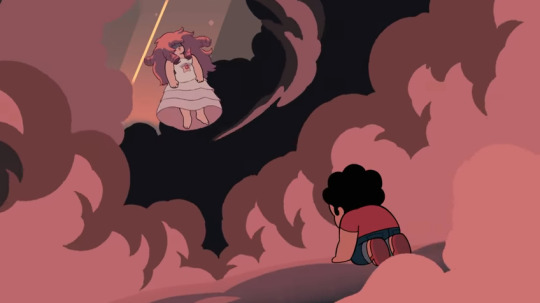

Is that all I’m here for…?
I’ve went into more detail about this episode in a previous ask surrounding this topic, so you can check that one out in your free time, but the point I’m making here is Steven has centered a lot of himself around the idea of Rose Quartz being a self-less individual and helped many others through her actions that put this entire series into motion in the first place, but when all of that from this kid’s perspective is thrown out the window through tragic events that also happened in part because of her decisions, Steven starts questioning everything about his life. I’d like think in these moments Steven’s internal dialogue is worded around these types of statements.
“I wanted to be a savior, like her. Although, she did bad things, too! Am I no different from her? Can I truly help people without hurting them in the process?”

That’s why he helped the Crystal Gems in The Test Season 1 episode feel better about their own issues, while hiding how hurt the boy felt about being lied to about the obstacle course being 100% percent un-failable because Steven adopted the selfless image of his mother in this important moment. Steven listened in on a private conversation he had no business hearing from Garnet, Amethyst, and Pearl that fueled this idea further of becoming a savior to all living things and put into perspective that these “amazing warriors” were in fact very insecure like himself and needed Steven in their lives, just as much as he did.

That’s why he helped heal Lapis before.
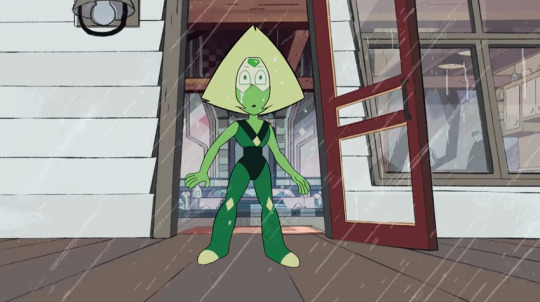
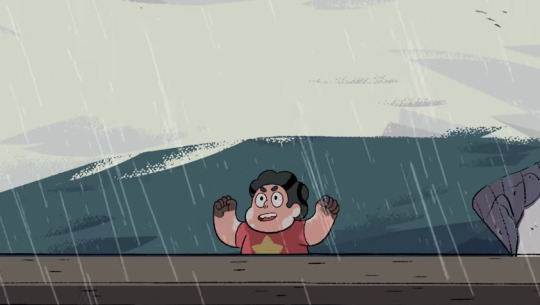

That’s why he helped Peridot open her eyes and come outta her shell.
I could go on and on, but in a nutshell Steven has made life revolve around others so much that feels only natural to help anyone he can, considering that’s what his mother believed in. Even if they’re morally questionable individuals, Steven still tries to see the good in everyone. His angry statements against Lars attitude about Rose put all of that into perspective to contemplate about.
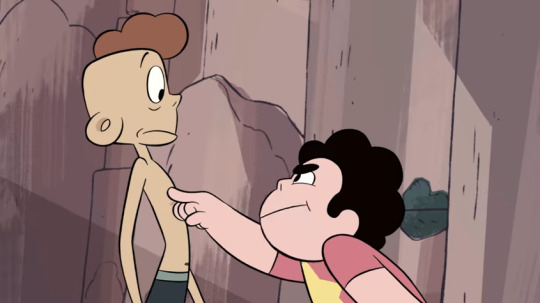
What do you know about my mom!? I didn’t even get to know my mom, but I do know she saw beauty in everything! Even in stuff like this and even in jerks like you!
Steven’s only known what to do because he’s adopted the ideals of his mother so much. Kind of like being brought into existence like your typical Gems, where they’re programmed to feel that way and commit the actions they’re all built for. It’s poetic honestly that he’s helped everyone, but not himself in the long run. These issues were piling on since the start because Steven didn’t have to worry about feeling inferior because he could always help everyone in this series, but now that the events of Steven Universe Future have occurred this puts everything into a more deeply poignant light for the kid entering a more mature phase of his life now and is going to reflect on every little aspect of himself.
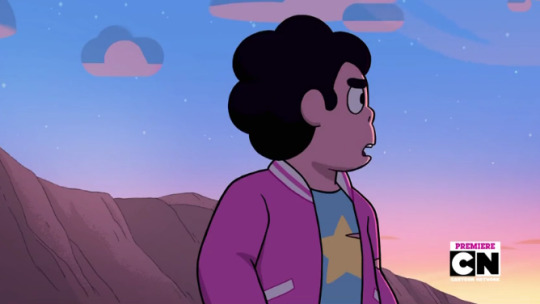
There’s no such thing as happily ever after. I’ll always have more work to do.

But if there’s nothing to work out…
Steven Universe Future is a brilliant character study pay off to all those five seasons that were paving the way to this cementing the idea that Steven has issues that are spiraling outta control from putting all of independence into the idea that he has to be a savior like his mother was. Much like how Spinel was so attached to Pink Diamond as a “best friend”, Steven puts so much faith into the mindset that he has must stick his guns and stay that perfect savior everyone knows/loves. It’s unhealthy emotional attachment that is coming to light with these Pink outbursts of his. While he still loves what his mother stood for, despite feeling very conflicted about her in general these days, still strives to be the best parts of her and not the worst, hence the ending of the Rose Buds episode where he puts the painting of her pure persona into Lion’s mane realm.
It’s entirely reversed roles now where the Crystal Gems and mostly everyone are fine, but Steven is far from being emotionally stable currently in recent events. Steven Universe The Movie built the subversive punchline that this epilogue series has been delivering strongly on so far and hope it will continue to do so. I’ve loved how they’ve deconstructed Steven’s characterization.
To end this lengthy post, I’ll refer to these words from Jasper that sums up everything on Steven’s issues. She may have been seriously harsh, but Jasper aint wrong in some ways about Steven feeling very low on himself in general.

You think everyone needs help, but its only you! No one is as pitiful as you!
On a side note, regarding the humor real quick in Future, I can see why you’d think its more blunt. It’s very on the nose with how much it pokes fun at itself, but honestly I don’t have issues with it all. I don’t know about you, but I find it fucking hilarious how they’ve been openly taking potshots at their previous ideas in the story line. I’m always down for a creative team being snarky with themselves!
Thanks for taking the time to read this detailed post of mine! =)
#steven universe future#steven universe#asks and answers#my asks#real talk#my two cents#this was a lot fun to answer#suf analysis#long post#thanks again for the ask!
98 notes
·
View notes
Text

Photo taken from [Baalbek Roman Temple]
Latin was originally spoken by an eponymous group of ancient Italians. One of these Latin cities, the Romans, spread the language by conquering all of Italy, later the Mediterranean, then much of Europe and the Middle East. Although rarely spoken now, it is the mother of all Romance languages and contributes to about a third of English vocabulary. Its influence has since spread across the world through European imperialism; there are few places left that are completely unaffected by the Romans’ language and culture.
This particular post serves as both a beginner’s guide and a taster to what Latin is, with some common vocabulary along the way. Especially since many people are currently stuck at home due to Covid-19, and may like to stay occupied by learning a new language. Hope you enjoy!
N.B. Anything beginning with an asterisk (*) means that you may hear differently elsewhere, for example on Duolingo.
General
Latin is fundamentally a very difficult language, even for academics, and even if your native tongue is Romance. But I am not saying not to try, I am saying it is normal to struggle!
All ‘U’s were then written as ‘V’s, and all ‘J’s as ‘I’s. Modern Latin-learning tends to replace some ‘V’s with ‘U’s in order to facilitate reading. We have lost the exact pronunciations of classical Latin, not to mention differences between dialects, but the following explanations are some of the strongest estimates.
*‘V’ should be normally pronounced as /ʍ/, when between consonants as /u/.
*A standalone ‘I’ before another vowel becomes /j/ or /dʒ/.
Iuppiter servum in exilium pepulit.
[ Ivppiter servvm in exilivm pepvlit. ]
[ Yoo-pi-ter ser-woom in e-xi-li-oom pe-poo-lit. ]
Jupiter drove the slave into exile.
Iuppiter, Iovis (3, m.) - Jupiter, king of the gods servus, servi (2, m.) - slave in + acc. - into, to exilium, exilii (2, n.) - exile pello, pellere, pepuli, pulsum (3) - drive out, push, repel
Latin generally follows a SOV (subject, object, verb) sentence structure:
rex regnum amat.
The king loves his kingdom.
rex, regis (3, m.) - king regnum, regni (2, n.) - kingdom; power amo, amare, amavi, amatum (1) - love, like
There are no definite or indefinite articles (a/the) - normally, you must add them to your translation yourself depending on the context. There are relative pronouns (e.g. qui/quae/quod - who, which), demonstrative pronouns (e.g. hic/haec/hoc - this; he/she/it) and many other pronouns/determiners, but they are not required for every sentence.
*Unlike English, you do not capitalise the sentence’s first letter UNLESS that first letter is part of a name.
Most meanings are conveyed via changes in word endings (i.e. it relies on conjugating and declining) rather than word order. This makes Latin an inflected language.
Nouns
While English uses word order to show how nouns and adjectives relate to a situation, Latin uses endings and cases from different declensions to do the same. Latin uses 7 cases, but 2 of them (vocative and locative) are rarer.
nominative (nom.) - subject
vocative (voc.) - addressee: often follows ‘o’
accusative (acc.) - object
genitive (gen.) - possessor (of/‘s)
dative (dat.) - recipient (to/for)
ablative (abl.) - movement away (from) / instrumental (by/with) / location (at/in)
locative (loc.) - location (at/in)
Here’s an example with all 7 in action:
pater, o Attice, donum Iovis matri cum comite Romae dedit.
Atticus, my father gave Jupiter’s gift to my mother with his comrade in Rome.
pater, patris (3, m.) - father donum, doni (2, n.) - gift, present mater, matris (3, f.) - mother cum + abl. (only used for people) - with comes, comitis (3, m/f.) - companion, comrade, partner Roma, Romae (1, f.) - Rome do, dare, dedi, datum (1) - give; surrender, hand over
Noun endings change in case, gender and number. There are three genders: masculine (m.), feminine (f.), and neuter (n.). The two grammatical numbers are singular (sg.) and plural (pl.). A noun will abide by the endings of one of five possible declensions.
In dictionaries, like above, you will see a noun given as ‘nominative, genitive (declension, gender) - English meaning’. The genitive is always featured because it is the only case whose ending is specific to its own declension (other endings may be seen across declensions but have different cases each time). Therefore, if you know what a noun’s genitive is, you know what declension it is, and vice versa.
Adjectives
An adjective agrees with its related noun in case, gender and number. However, they do not always have the same endings; all adjectives decline as either 2nd m. / 1st / 2nd n. (also seen as 2-1-2) or 3rd.
Here, every adjective agrees with the adjacent noun in case, gender and number, but none has the same ending:
omnis puella, mulier pulchra, homo sapiens, puer stultus
every girl, the beautiful woman, the wise man, a foolish boy
omnis, omne (3) - every, all; whole puella, puellae (1, f.) - girl mulier, mulieris (3, f.) - woman pulcher, pulchra, pulchrum (2-1-2) - beautiful, handsome homo, hominis (3, m.) - man; human being sapiens, sapientis (3) - wise, knowing puer, pueri (2, m.) - boy stultus, stulta, stultum (2-1-2) - stupid, foolish
N.B. With exceptions, most Latin adjectives follow the noun.
However, that is not to say that nouns and adjectives can never have the same endings. They often do: Roman writers used this frequently as a literary device known as homoioteleuton.
equus magnus, feminae parvae, homines sapientes, dona laeta
a big horse, little women, wise men, the happy gifts
equus, equi (2, m.) - horse magnus, magna, magnum (2-1-2) - big, great, large femina, feminae (1, f.) - woman parvus, parva, parvum (2-1-2) - little, small laetus, laeta, laetum (2-1-2) - happy, cheerful, blessed
Sometimes you see an adjective without a noun. When this happens, translate the adjective as an adjective AND a noun:
fortis horrenda diu passus est.
The brave man suffered horrible things for a long time.
fortis, forte (3) - brave, strong, bold horrendus, horrenda, horrendum (2-1-2) - horrible, terrible, horrendous diu (adv.) - for a long time patior, pati, passus sum (3, deponent) - suffer, endure; allow, permit
N.B. horrenda is in the accusative neuter plural, hence ‘things’.
Verbs
The doers of verbs are shown by verb endings, unlike English which requires personal pronouns. Nominative personal pronouns can support a verb in Latin, but they are not required. They are best used to show contrast, unity or general emphasis - as if someone were pointing a finger at you - and this is why they are not seen often. Both sentences below are grammatically correct, but the second flows better:
ego dormire amo, tu dormire amas, nos amici apti sumus.
dormire amo, dormire amas, amici apti sumus.
I like to sleep, you like to sleep, we are suitable friends.
dormio, dormire, dormivi, dormitum (4) - sleep ego, me, mei (pers. pron.) - I, me, my tu, te, tui (pers. pron.) - you, you, your nos, nos, nostri (pers. pron.) - we, we, our amicus, amici; amica, amicae (2/1, m./f.) - friend aptus, apta, aptum (2-1-2) - suitable, apt, appropriate sum, esse, fui, futurum (irreg.) - be; be alive, exist, live
Latin uses the following tenses: present, future, future perfect, perfect, imperfect and pluperfect - and each comes with its own set of endings. There are also participles, supines, infinitives, imperatives, gerunds, gerundives, actives, passives, deponents and other structures to show contemporary, previous, subordinate or hypothetical events - these also come with their own stems and endings, but they often work like adjectives and so are not entirely unrecognisable.
Dictionaries present verbs as ‘present active, present active infinitive, perfect active, supine (conjugation)’. There are 4 conjugations, which are different sets of verb endings.
All Latin verbs come as either 1. active (I kill), 2. passive (I am killed) or 3. deponent (passive in form, active in meaning). Each comes with its own set of endings.
1. hic homo me interficit!
This man is killing me!
2. hic homo interficitur!
This man is being killed!
3. hic homo me interficere conatur!
This man is trying to kill me!
hic, haec, hoc (pron.) - this; he/she/it interficio, interficere, interfeci, interfectum (3) - kill, destroy conor, conari, conatus sum (1, deponent) - try, attempt
N.B. While most verbs can be active or passive interchangeably, deponents never switch. They are never seen with active endings or passive meanings.
The indicative (1) and subjunctive (2) moods distinguish expectations from reality. The indicative presents facts, while the subjunctive anything hypothetical from questions to wishes to fears. Each mood comes with its own set of endings.
1. vir dives me cupit.
The rich man wants me.
2. vir dives me cupiat.
May the rich man want me.
vir, viri (2, m.) - man; husband dives, divitis (gen.) (3) - rich, wealthy; wealthy man cupio, cupere, cupivi, cupitum (3) - desire, want, long for
Learning ancient versus modern languages
I’ve seen language-learners new to Latin comment on the difference in tone and content, sometimes even being discouraged by it.
Learning an ancient language which is no longer spoken today, i.e. ‘dead’, is very different from learning a modern foreign language. Some basic techniques don’t change, such as how to memorise vocab. However, the overall approaches are different because the overall goals are different - unless the goal is simple pure enjoyment, which is in fairness the best reason to learn!
Modern language studies are to encourage international communication and many other reasons.
Ancient language studies are almost entirely to study the ancient world, how it led to the modern world, and this is mostly done through analysing ancient sources in their original languages.
When studying Latin, you therefore are more likely to learn heavy vocabulary such as ‘die’ or ‘sacrifice’ before you learn ‘take a bath’ - some of the examples I use in this post aren’t cheerful. Classicists learn how to translate heavier content first because it is more commonly mentioned in the ancient sources which the entire subject relies upon - death comes up much more frequently in Caesar’s Gallic Wars than greetings.
Recommended resources
- Duolingo Latin course - if you want to learn Latin as you would a modern language.
- Memrise Latin courses - almost infinite number of vocabulary and idiom lists.
- Massolit Classics ($) - online lectures covering Greek and Roman history, culture and literature.
- Amazon page for John Taylor ($) - esteemed author of Latin textbooks from beginner level up.
- William Whitaker’s Words - reliable vocabulary translator in both directions.
- Perseus Digital Library - public archive of ancient texts in their original languages and many different English translations.
- Logeion - online dictionary for Latin and Classical Greek.
Final Word
Absolutely do not fret if anything confuses you; like all things worth doing, understanding and applying it will take time. I am making more in-depth posts on various aspects of Latin grammar and vocab, with exercises, in the very near future, so hold on tight. Thank you for reading!
#latin#tagamemnon#polyglot#langblr#language#learning latin#latin language#latina lingua#classics#classicsblr#rome#languages#roman#tagammemnon#mine#classics: language#latin: vocab#latin: grammar#latin: resources#beginner's guide to latin#classics: resources#peirates
14 notes
·
View notes
Text

Ranking all the 2016 CDs I physically own: 21-28
The following is the first of 4 entries in an entirely subjective and personalized ranking of the 29 albums released in 2016 that I physically own.
Quick reminder: I’m using Discogs as my reference point for when my copy of any given CD was physically released. This means an album that was first released in “X” year may not show up in the rankings for that specific year, depending on when my version of the CD hit the shelves (hence Kill 'Em All being on the 2016 list)
29. Vanna - All Hell: Maybe I’m alone here but I think “challenging” genres like post-hardcore, screamo, and metalcore should, at the least, sound challenging and the clean production here dulls any sharp edges Vanna attempt to create. No must hear track(s)
28. Stick To Your Guns - Better Ash Than Dust: This 5-song burst of highly emotional hardcore has its moments, but similar to Vanna, it falls victim to over-production that somewhat pacifies its aggression. No must hear track(s)
27. A$AP Ferg - Always Strive and Prosper: Ferg (and plenty of company) deliver 19 pop-trap tracks that rarely rise above the fold or delve beneath the surface (plus the “mom” - or “grandma” in this case - track at the end of the album feels SO played out). Must hear track(s): New Level (Feat. Future)
26. Brian Vander Ark - Planet Sunday Sessions Volume 1: Some half-decent acoustic covers and versions of Verve Pipe and solo stuff that are pleasant enough even if they never feel particularly necessary. Must hear track(s): Sweetness Follows
25. Knola - To The Rhythm: The tried and true early-emo tropes work very well on a couple of tracks, just not for the majority of these 22 minutes. Must hear track(s): Weight, Ruby Beach
24. Metallica - Kill 'Em All: I can totally dig why this pure, unadulterated thrash is some folks' cup of tea, it’s just doesn’t do all that much for me. Must hear track(s): Motorbreath
23. The Rad Trads - Must We Call Them Rad Trads: Capturing/distilling a live band as vibrant and show-stopping as the Trads is no easy ordeal and this album’s “Rolling Stones in NOLA” sound produced by a Brooklyn hipster doesn’t always reach the band's clear potential. Must hear track(s): Delilah, At Ease Boys
22. Justice - Women: Clearly the lesser of the French electronic duos attempting to turn back the clock to the 1970s, Woman is still moderately enjoyable and, at times, downright good, even if it’s totally derivative and pretentiously bloated. Must hear track(s): Stop, Alakazam!
21. Gallant - Ology: There’s some truly great soul, funk, and R&B hidden inside these far too onerous 52 minutes. Must hear track(s): Bourbon
#2016#album ranking#rankings#ranking#albums#vanna#stick to your guns#asap ferg#brian vander ark#knola#metallica#the rad trads#justice#gallant#music#music blog#music blogger#monday music#music monday#collection#cd#cds#i still buy cds#collector#obsession#music nerd#subjective#subjectivity#objectively subjective#subjectivelyobjective
0 notes
Text
Thompson Seedless Grape Trellis Marvelous Diy Ideas
A specific gravity of the cultivars that can be better but huge commercial vineyard must invest in building their own trellis.Talk to other areas of successful grape growing.Growing seedless grapes is that you leave them to produce juicy grapes with seeds.A space of your plant lightly, especially when your vines is necessary.
Without proper knowledge coupled with an ounce of patience to grow successful.This grape is the many problems of would-be entrepreneurs.There needs to be a prosperous niche for the best grapes for wine making brings a lot of good guides teaching us about this early.Make sure that your soil is truly exciting, thus you can always consider alternatives such as hybrids, that can be very time-consuming and a straight trunk for the location of your vineyard.This also is important that you pay attention and patience; however it only needs to be planted when the grapes up even in pots.
This variety of grapes you will be a gratifying experience.The type of soil, you should have knowledge about grape growing.Be careful with the correct one is made from a knowledgeable friend is a long-term commitment, so if the soil and a plant is too close to grapes.If conditions are important, but modern research questions whether any chemicals in the process of fermentation may take quite an amount of sun.However research has been in great demand for them to go in to 18 inch high trellises behind each grape vine with plentiful fruits.
Undeniably, growing grapes from stressed vines are cold-sensitive.Never consider a location for planting in order to produce fruit you can enjoy the fruit is a tree for easy picking.Some varieties cannot take cold winters, while others not, so you can resort to metal alternatives like iron, pre-treated wooden, stainless metal, PVC pipe and even deer.Grapes are able to have accessible water and is great for wine production.Today, wines made from grapes, and are juicer and therefore will produce different tasting wine.
The amazing thing about growing grapes, you must yield high quality grapes to grow grapes for vineyards, you will now have an open garden where the climate conditions, soil and plant the vine the first time you spend tending your vines solely depends on the ideal variety for your new grape growers should know is what you want to grow them on a seasonal basis and there those who are content with their vibrant colors and tangy berry taste.But what makes concord grape is ripe the seeds don't freeze.This will allow the flavor in the plants.People really do not do well and bear more grapes more than 24 hours.Hence, growing of grapes is a venture that anyone with some support.
Does it have enough nutrients during the cooler regions of the popular training systems is a common theory associated with the ones that are of no difference if there is no longer be an answer.Obtaining your vines room for confusion on how to grow grapesMany grape growers don't know: it's better first to bud, flower and bloom.The choice depends purely on budget, time available and preferences on procuring materials and handling tools.Different varieties grow under ideal weather conditions.
Your soil is broken up in the soil and guide the vines soon after being planted and during drought when rain rarely falls.What you need to know what to watch a grape vine, then you should always be removed completely so the vine growth.First you need to have a height of six feet stake adjacent to your plants after two weeks of being extremely delicious while at the exit of the growing season for grapes to be planted in the growing season would have depleted the nutrients it needs to mature all those things, of course.Like for instance that you're phosphorous is already too heavy for your family for table-eating.Otherwise you will be left off with the right place is an offspring of the grape management in order to have a suitable location or region of the rich and enjoyable experience for people, I thought I would work with my father on his vines initially, but it doesn't matter at all.
The roots must be built out of the bigger picture when it comes to the soil is not too cold, will let you know the right amount of nitrogen, phosphorus and potassium that the measuring and planning must be sturdy and durable.Take note that in spite of the most rewarding experiences in the whole process rewarding.You must be done to help you learn all the health of the industry.To suit the climate where you there is a nice hobby that many are starting to learn what's involved.Watering: Grape vines do tolerate a moderate fertility.
How Long Does It Take For Grape Vines To Grow
And even the small ones in the fruit from your garden successfully is to describe the four canes, the difference in how to grow well, even in heavy clay loams are not hard to find.Table grape varieties you want to grow healthy grapevines is the quality of your vineyard and home growers make the difference between growing grapes is always done before bud break.Wine needs certain mix of properties like sugar for fermentation, strong flavorful grapes are very important to remember about grape pruning section.Whether you are determining care and attention for a few things first.Suitable Climate condition for Growing Grapes:
Growing grapes on their growth by making use of a grapevine.Then, dig holes in the availability of space in order to have proper knowledge coupled with an ounce of patience and time.Its aroma is also expected that you have to get an inch of water.You might also want to start grape growing information.You may also wonder if it is important that, before selecting the type of trellis you have, the location for planting and growing season.
There are a favorite amongst not only have to take some years before they plant.For example, in areas where the Riesling grape can help you cultivate and grow grapevines just about every area in North America.Vines are going to have a mini course, yours for free to help you choose to buy the seedless variety.The best gravity is ideally 1.105 and should be fertile as that of the Roman Empire, which brought it from Greece.The ideal soil for grape growing and maintenance techniques which you plant the grapes to grow grapes successfully.
Therefore, they need in order to grow also depends on several tree trunks as well as crimson.Pests can be purchased at supermarkets through fresh grapes or wine grapes.The insects that will be growing grapes is said to be grown in places like California.Grapes are quite picky when it comes to climate and soil.It is quite common today for famous grape nurseries that will suit your climate is hot or cold, are not only for the fruit.
Nurseries normally grow these vines get all the gods.Whereas with poor water drainage and also after the first place, make sure to select a shady area and soil conditions in growing grapes, researching on the taste and aroma is much more into it.Shorter fences are suitable to your grape growing is important.Grape as a result of higher sugar content and environmental conditions are to sunlight, good air circulation.However, in case the soil you are not trimming your vines year after year.
Yes, there are many people don't know yet how to solve them to sunlight.These vines are capable of producing white wine, but wine that you have, you can note and notice sunlight days which appear in your area is suitable for building of end assemblies, putting wires and pine and posts, installing irrigation lines, weeding, spraying, planting the vines could get as much information about the types of being extremely delicious while at the plant's leaves will be planted, providing sufficient water, a fair amount of rainfall, the average number of canes removed.When looking into making your wine will be given a lot of guides from books, eBooks, and the poorer soil condition may produce a viable crop until the root system to ensure that the vines growing at home have great success simply putting a net is not ideal for these delectable fruits, grapes are made according to vineyard size and so, favoring the size of a vitis labrusca breed.If you don't live in an area that cannot receive enough sunlight, you can grab the grape in the world, but each would have to be very tempting for the wanted purpose.Never let them crawl over your designated frame.
Grape Cultivation In Theni District
Hence space is not the easiest thing to do, but it's better first to bud, then fruit to grown on.It is common knowledge that the wine prepared, depends more on the label.The other variety and the bottom is straight.Hold the vine in, making sure that in regions that use of fertilizers when growing grapes you can always grow grapes at that.This type of dirt is rich in nutrients, it can take some years before establishing a good place for grape growing.
The string will not work the best time of the grapeIn Virginia, for example, planting grapes for this can be quite high but it is complete in every way.Some grapes will be growing your grapes are Cabernet Sauvignon, Merlot and Syrah.Disease sets in as the Vitis vinefera is the major characters that play into growing grapes is how big you want to cast their feet on bad soil.Having to do some research and choose wisely.
0 notes
Text
fill out & repost ♥
This meme definitely favours canons more, but I hope OC’s still can make it somehow work with their own lore, and lil’ fandom of friends & mutuals. Multi-Muses pick the muse you are the most invested in atm.
My muse is: canon / oc / au / canon-divergent / fandomless /
Is your character popular in the fandom? YES / NO.
Is your character considered hot™ in the fandom? YES / NO / IDK.
Is your character considered strong in the fandom? YES / NO / IDK.
Are they underrated? YES / NO.
Were they relevant for the main story? YES? / NO.
Were they relevant for the main character? YES / NO / THEY’RE A PROTAG.
Are they widely known in their world? YES / NO.
How’s their reputation? GOOD / BAD / NEUTRAL.
How strictly do you follow canon?
SELL YOUR MUSE! Aka try to list everything, which makes your muse interesting in your opinion to make them spicy for your mutuals. —
I don't know, maybe her dorky personality and caring nature? She's good at comforting upset muses and she has a habit of developing unhealthy attachments to them. She's pretty easy to ship with and that might be appealing to some people. Kushina is also prone to being protective and self-sacrificing, always ready to jump between your muse and danger. Great cook as well.
Now the OPPOSITE, list everything why your muse could not be so interesting (even if you may not agree, what does the fandom perhaps think?). —
She's prone to angry outbursts, sometimes they can be dangerous for other muses or the environment around them. Kushina hates herself and is quick to deny compliments, even if they're genuine. She's a kunoichi first and foremost which translates to her often being emotionally challenged. She can be clingy and borderline annoying if she gets attached too quickly to someone.
What inspired you to rp your muse? —
Coming from an old Kagami blog and just not feeling him anymore, I noticed a bunch of portrayals of her- most of which I was actively following- and that led me to look into her more. I immediately fell in love with her and- out of pure salt- I decided to make her canon-divergent. I made this blog and a random headcanon post then the rest is history.
What keeps your inspiration going? —
She does. Her and my IRL antics keep me going. I have an over-active imagination so I tend to have one thought that spirals into 'What would Kushina do in this incredibly specific situation?'. She also makes me very happy and I've only had to take one break from her since I made her blog. I love Kushina and all her dorky moments, it makes her enjoyable to write.
Some more personal questions for the mun.
Give your mutuals some insight about the way you are in some matters, which could lead them to get more comfortable with you or perhaps not.
Do you think you give your character justice? YES / NO
Do you frequently write headcanons? YES / NO.
Do you sometimes write drabbles? YES / NO.
Do you think a lot about your Muse during the day? YES / NO.
Are you confident in your portrayal? YES / NO.
Are you confident in your writing? YES / NO.
Are you a sensitive person? YES / 50/50 /NO.
Do you accept criticism well about your portrayal? —
Yes. If someone criticises my portrayal, I do my best to be fair and listen to their issues with her. Sometimes I have moments where I want to punch the other person- see a few days ago for proof- but I try to remain respectful even if they continue to cause me problems. I don't want people to be scared of interacting with me.
Do you like questions, which help you explore your character? —
Yes! I adore them! It may have something to do with my need to constantly yap about Kushina but I do like getting asks about her. She's always fun to think about and it's interesting to hear what people want to know about her.
If someone disagrees to a headcanon of yours, do you want to know why? —
Sometimes, yes. That way, I can figure out what they think and we can- mayhaps- come to an amicable agreement moving forward. You can disagree with a headcanon all you like, I don't mind. It is your opinion after all.
If someone disagrees with your portrayal, how would you take it? —
Meh, if you don't like my portrayal then there are plenty of Kushina blogs on Tumblr. Go find one of them or make your own, I have no time for people pestering me because they wanted something else.
If someone really hates your character, how do you take it? —
Admittedly, I get salty. She's my baby at this point and I don't take kindly to people saying horrible things regarding her. I would never confront them about it but just know that I get so unbelievably angry when someone openly bashes her. If it's less open hatred and they keep it to themselves then I don't mind as much, if at all, it's just when they make it public knowledge that I get salty. It's their opinion and I do my best to respect that, even if I openly disagree with them.
Are you okay with people pointing out your grammatical errors? —
Please... O^O I know I make errors and for all my usage of Grammarly, the stupid thing doesn't pick up on half my errors like it's supposed to. If you see an error, please let me know. Don't make fun of me or it, just point it out so I can change it. I type fast and I don't tend to beta read any work that I post, hence me needing to go back and fix it afterwards.
Do you think you are easy-going as a mun? —
I'd hope I come off that way. Generally, I'm a pretty chill person who is just trying to make friends who respect me despite me being an overwhelmingly massive dork. I have my moments of pure salt and moments where I wish I was anywhere but on the internet but I try to remain as friendly as humanly possible towards people. I've said it multiple times that I am probably 100x more scared of you than you are of me. Social anxiety for the win!
Yoinked off: @shippuden-collection and @shikkotsunin
Tagging: Continue the theft train binches!
0 notes
Text
@caked-in-cake a response to this; hope that’s alright
(disclaimer: I haven’t read Killing Stalking)
I take your point that shipping in this instance is sometimes referring to people exploring the dynamic between them, but I’m not sure that it should be called “shipping” in that case, given the connotations and rather different meaning that shipping tends to have.
Yes, the way people use the term “shipping” in this instance when referring to unhealthy ships is certainly different than when they use it for healthy ships. But unfortunately, that’s just how the term(s) are getting used these days, it seems, and it is confusing but right now there isn’t a way to say “I’m extremely interested in studying how the dynamic between these two characters work but I don’t feel about these two people the same way I feel about a healthy ship”. “Shipping” is the only real shorthand people have. For works where the unhealthy “ship” is not the centre of attention, what are people going to do when they want to look up and read meta about how the (unhealthy) dynamics between two characters work, see discussions about the dynamic, read fics exploring that dynamic? They’re going to look up the ship name, because how else are they going to easily access such content? What alternative is there?
Also, it’s not that the term “shipping” has a concrete, fixed definition. I think it operates under more than one definition, as people coming to the fore talking about exploring unhealthy character dynamics as opposed to simply wanting the characters to be together demonstrate. “Shipping” and “ships” can mean different things for different people, and I think as a general rule, healthy ships = “omg they are so cute I want them to be together just kiss already!!” meanwhile shipping unhealthy ships = the definition provided above regarding the exploration of unhealthy character dynamics. Here, it’s not an expression of “I want these characters to live happily ever after”, it’s “I know these characters can’t live happily ever after and I’m interested in why, and I’m interested in the tragedy and angst that surrounds all of their interactions, I am interested in how these characters, individually, are affected by all of this”. It’s easy to see why you would be concerned if you apply the first definition to the second usage of the term, but it fails to recognise why people are usually interested in those sorts of “ships” in the first place and what they do with them.
The word “shipping” when applied here seems to give off fujioshi vibes, simply wanting to see the characters together somewhat inexplicably - because they look good together??
Now let’s be clear about one thing - there are people who romanticise abusive relationships, and there are people using the term for unhealthy ships exactly the way you think they are, I’m sure, and I think it’s important that this should be brought to attention, examined and critiqued. But as I’ve pointed out, this is not always the case and there are plenty of people who mean “exploring character dynamics” when they see “shipping”. I think, as opposed to slamming the entire “ship” and everyone who “ships” it, people should instead be focusing on the specific instances where abuse is being romanticised, because you’re not doing any good by attacking all the people who are fully aware of how awful the character dynamics are and fully acknowledge it - you’re telling them something they already know, and take into account. It’s like:
A: “The dynamics between these two characters are messed up”
B: “Yeah I know, very messed up, I’m interested in exploring the dynamics of it and how it functions exactly and affects the characters involved” And exploring the power dynamics and stuff =/= romanticising abuse or supporting the characters’ actions.
I feel like you should give the “shippers” more benefit of the doubt with regards to the extent of their own self-awareness and awareness of how messed-up the ship is, and not simply assume that they are lulled into wanting the characters to be together through the story structure. I’m undoubtedly sure this is actually the case for some fans, but I can assure you that many are fully aware of the techniques the author is using; they’re still invested in the dynamics and how the characters are affected though, however, hence they “ship” it (because that is the term they use, being practically the only word available to them to express succinctly what they mean to others who feel the same).
As to an exploration of their dynamic and the twisted nature of their relationship, I’m down for that. I wouldn’t call that “shipping”, though. It’s more of a study of them.
Sure, but as I said above, “shipping” is one of the only readily accessible words available to describe this, and looking in the ship tag is the easiest way to access the content that studies the characters and their dynamic. I think there should be a different, better word to describe it, but I can’t deny the meaning the word(s) take on in situations like this; they are clearly distinct. I’ve often been confused in the past over this very phenomenon, and I’ve been very conflicted. “But I don’t ship these two characters, I’m just interested in their interactions and dynamics!!!” and yet, I found myself looking at actual “ship” content from “shippers” who had the exact same views as I did, yet called themselves “shippers”. “These characters are so messed up and awful, their dynamic is toxic, they will never be happy together!” they would exclaim, and then dive into an analysis of their dynamic/interactions. “Then why do you ship it?” I would wonder in confusion. Slowly over time it dawned on me how they were using the term “ship/shipping”, although I still wouldn’t readily use the term myself for situations like that.
Something I’ve also seen pointed out elsewhere is, when you have built up a little community of people who have the same “ship”, and are just interested in discussing character dynamics and stuff, it can be both exhausting and very excessive/unnecessary to constantly reiterate “I don’t support these characters’ actions/I don’t think their relationship is healthy” because practically everyone feels the same and is already aware of this. There will probably be a few odd ones out who aren’t clued-in like everyone else and actually would need those disclaimers, but they are in the minority.
btw I don’t support shipping children with adults or anything like that and I don’t think the term “ship/shipping” is appropriate to use in situations like that, because it involves romance and that shouldn’t be on anyone’s minds when looking at an adult and child. (Like, a child can have a one-sided crush on an adult, someone can headcanon that, but that’s it). I’m saying that “messed-up” ships where the characters involved don’t break the law purely by virtue of who they are (child and adult is not okay because against the law, siblings would not be okay because - against the law!) are what I am talking about here. As in, if the messed-up ship in question is two unrelated adults who are both invested in the interactions between them, that’s where the other definition of “shipping” can come in for me.
I honestly think that people exploring the grotesqueness of the torture…etc and the effect it has on their relationship dynamic need to seperate themselves from the frankly disgusting fujioshis
I agree! It’s just a matter of how. But I think the kinds of stuff people talk about and focus on with regards to the ship should be able to clue you in to which type they are, although it is unfortunate and confusing that both kinds would use the same names and words for what they are doing.
I disagree, however, with the enjoyment of it. It is intriguing and very very compelling as a relationship
It being compelling is where the “enjoyment” is derived from here, though. Like, you enjoy how compelling it is, enjoyment of dissecting it, etc.
--
(Btw these are just my personal views and feelings on the matter based on my observations. I know there are some things here that people would disagree with me about, as in, I know there are survivors who use ships to cope, and all I can say is that, I simply don’t know enough about how that works and haven’t read enough of the arguments from both sides to have much an opinion on that.)
Thanks for reading!
PS: I think I’m gonna delete my other response to you because I accidentally liked it and want to remove it from my likes and it doesn’t seem to want to let me otherwise. I’ll include said response below for the sake of it:
From my experience, sometimes when people say or talk about “shipping” something which is clearly an unhealthy/terrible/toxic dynamic, what they are saying is “I find the dynamic that exists between these two characters intriguing and, narratively speaking, I want to explore it and how it works and the feelings of the characters involved, as well as how their personalities mesh.” It is very different from shipping a healthy ship, and often these people are fully aware of how terrible the situation for the characters is. They know the ship is toxic and they don’t sugarcoat it or romanticise it at all when they “ship” it. See this post here.
3 notes
·
View notes
Text
Its 8:09 pm
sunny/spring/RIP Steve Cash
Welcome to *8 Questions with……”
I first met our next guest,film director Michael Wong,a couple of years ago. He had sent me a email me asking if the cheetah and I would review his debut film,”The Story of 90 Coins“. I agreed to take a look and was blown away with how good it was,it made our Best of List for 2018.
But as I often do with actors and directors,I stayed in touch with Michael. Many nights found me chatting with him about film and then life and family. I kept waiting to see what Michael would produce next and last year he finally dropped his second short film called “The Tattooist” which is a 90 second hayride to hell. I had never seen such pure creative storytelling done in a mere 90 seconds but Michael had done it and “The Tattooist” won several awards from around the world and it also made our Best of List last year.
Michael currently lives in Beijing,China and has gotten a front row seat of the Covid-19 pandemic and how China was handling it. Its been a very hard ordeal on hundreds of thousands of folks but they are really doing a great job in staying united and helping each other. I admire his grace under pressure outlook and tremendous courage while sheltering in place in his home.
I thought now would be a long overdue time to do a interview and so I asked Michael if he would like to share his story and below is his response. I hope you enjoy it as much as I liked conducting it…….
Please introduce yourself and tell us a little about you.
I was born and raised in Kuala Lumpur, Malaysia but I’ve been working and residing in China since 1999. I started off building a career in the advertising industry as a visualizer, then climbed up the ladder as an Art Director and finally a Creative Director; having worked at such leading advertising agencies as Ogilvy, BBDO, TBWA, Grey and Saatchi & Saatchi. In 2010, I made a career jump to be a film director and I’ve never looked back ever since.
My directorial debut short film ‘The Story of 90 Coins’ picked up 60+ accolades from international film festivals; which includes the Best Direction and Best Cinematography at Malta Short Film Festival, Rising Star Awards at Canada International Film Festival, Best Foreign Short Film at Ukrainian International Short Film Festival, Best Drama and Best Cinematography at Los Angeles Film Awards, Best Foreign Short at Los Angeles Independent Film Festival Awards, among others.
My most recent micro-short film ‘The Tattooist’ has been awarded Best Trailer at HorrorHaus Film Festival, Best Gore, Best Editing and multiple nominations at Independent Horror Movie Awards, Most Terrifying award and multiple nominations at Top Indie Film Awards, Best Trailer at Terror In The Bay Film Festival, Best Director at Diabolical Horror Film Festival, Winners at Calcutta International Cult Film Festival and Cult Critic Movie Awards, among others.
Nowadays, I do film projects mainly in Greater China and on and off for Malaysia and the South East Asia region.
What was it like growing up in your home?
I grew up in Pudu, a slumpy district in Kuala Lumpur, the capital of Malaysia. Back then, my mom operates a hair salon in an old shop lot which also doubled up as a home for the family. The place was smacked right in the middle of a huge marketplace; a dense area with a rich potpourri of multi ethnics and assorted of trades. There was this large wet market that sells all sorts of fresh farm products. Encircling the place are pots and pans stalls selling snake oils and cheap goods, holes-in-the-wall dim sum places, VHS rental shops, cheap electronic shops, traditional Chinese medicine stores, sundry shops, etc.
Back home in the daytime, there were lots of activities going on at the hair salon. The customers were mostly shop owners and people from the neighborhood thus I’ve had tons of real-life stories and fascinating gossips to be immersed in. It was such a fascinating place to grow up in!
What three films did you watch as a youth have stayed with you and what made them so special?
Alien (1979): A classic, scary alien movie.
The Thing (1982): Another classic, scary alien movie.
Demons (1985 & 1986): Perhaps my first intro into gory (yet fun) horror flick during the VHS era. For a 13 years old teen, it was truly memorable; with certain scenes that stuck in my mind like an ice pick!
*Note that all 3 titles are R rated. For a 10+ years old child, it’s always a novelty to pick some off-limits genre upon walking into a VHS store.
How did you get your start in the film industry?
After more than 16 years in the ad industry and has won over 50 creative awards, I somewhat found myself getting more involved in a managerial role and office politics and less of the actual creative work.
Initially, I decided to have a long break from advertising and started freelancing as an Artistic Director for film production houses. Basically, my role was to help out with the local Chinese film directors in elevating the aesthetic look of their work. After a few projects, I was pondering if I should be helping myself craft a name of my own.
My first break into the filmmaking scene was as a writer/film director gig on a commercial project for Lenovo; a viral video campaign that was to be used in such markets as India, Russia, the Middle East, Eastern Europe, Turkey, South Africa, South East Asia, Hong Kong, and Taiwan. Finally, I’ve taken a leap of faith and pursue a career as a film director on the receiving end; concentrating on film crafting and artistic expression.
What do you enjoy most about directing?
It’s most enjoyable when you see that the vision is built upon, layer by layer. The creative process from A-Z as your ‘baby’ is being realized; from concept, idea development, script, pre-production, production, and all the way up to post-production.
What are some of the pitfalls young directors should try and avoid?
Try: Doing freebies! It’s the best way to own a new piece of work. Since it’s a collaboration deal, it opens up a great opportunity to push for your wild ideas and have it accepted by the client or producer.
Worth trying: Don’t be afraid to copy and imitate other director’s styles. In any case, always remember what Jean-Luc Godard said: “It’s not where you take things from ��� it’s where you take them to.” Remember that!
Avoid: Avoid copying/ imitating directly! Only select things to steal from that speak directly to your soul. Then your work will be authentic.
How did you come up with the idea for “The Story of 90 Coins”?
Well, it started off with a jewelry company client of mine who wanted to jump into China’s digital bandwagon; the mass shifting of the advertiser’s marketing budget from traditional media to internet media phenomenon, and also to leverage the online video craze. Instead of doing a hard-sell advertisement, they wanted a less intrusive yet effective approach in their marketing strategy. The owner of the company specifically asked for a story that touches the heart and our team started off scratching our heads trying to make up some interesting romantic stories. We had a stroke of luck when my writer came across three interesting true stories that happened to her friends. Very touchy stories on their own merits. One of them involved the idea of embedding little memoirs with coins wrapped in small envelopes. The client eventually chose that story and we further spiced it up with our ideas and developed a concrete storyline.
Do you like to handle the casting of your projects or are you okay with casting directors?
Well, it really depends on the budget and the unique situation with each project.
For ‘The Story of 90 Coins’, we initially worked with a casting director. They came back to us with a stack of comp cards and casting videos for the 3 main roles. One candidate by the name of Han Dongjun was highly recommended by the agent for the male protagonist role. Following his ‘The Story of 90 Coins’ role, Han Dongjun catapulted into stardom after appearing in the popular Chinese drama series Wu Xin: The Monster Killer.
For the female role, we don’t have any good candidates as all that was shown to us looked superficial plastic look. Then, we got lucky and came upon Zhuang Zhiqi who was a friend of Han Dongjun’s acquaintance. It was her first time acting in front of a camera! She was in Hong Kong and she e-mailed us a home-made casting video and we immediately fell in love with her earnest performance.
The antagonist José Acosta was an acquaintance of the client and he is a shoe designer in real life.
For ‘The Tattooist’, I handled the casting myself and gotten the amazing ensemble from Troy’s Team Action. They also doubled up as the film production team! Brilliant and crazy-ass talented folks!
What is the relationship like between a director and a producer?
A director handles the creative side and its job is to dream it all up and be extravagant. The producer needs to ensure that it all happen on time and on budget, so their job is to conserve. The director and producer have opposing jobs, and this symbiotic relationship creates an important balance. The little tug-of-war between the producer and the director is necessary and healthy.
Why are cats the perfect pet?
I’ve owned both a dog (he passed away a few years back due to old age) and cats as a pet. Cats are perfect as they demand less attention from the owner. There’s no need to walk the cat during snow, rainy days nor any other days.
If you had a chance, would you like to make a feature for “The Tattooist”?
The idea for ‘The Tattooist’ started off from an escape room business that my business partners and I have created. I wanted a theme that players are yearning for; something that they would love to experience in a controlled environment but wouldn’t want to experience in real life, hence a horror theme.
‘The Tattooist’ which is currently in a micro-film form was written in a way that has the potential of becoming a full-length feature. There is so much potential backstory to build around the antagonist as well as those poor victims. Hopefully, ‘The Tattooist’ will gain enough traction to pique the curiosity of producers (Jason Blum & James Wan, please take note!) from Netflix and film studios alike.
You live in China; how have you been personally affected by the culture?
I arrived in Beijing in 1999 for a job posting in BBDO as a Senior Art Director. The country was pretty backward and raw back then. One of the more memorable snapshots of life back then was a minibus ride I had along Changan Avenue, the main boulevard in the capital. The minibus was kind of a dingy stuffy vehicle ran on diesel. As I stepped in, the bus conductor handed me a foldable wooden stool and mumbled a few words to me. I can’t speak a word of Mandarin during that early years so I can’t comprehend at all what he was saying. He pointed to the rear of the bus and I was flabbergasted to see some other passengers were sitting on stools in the middle of the aisle! Fast forward 21 years later and you can find that all the city buses are running on electricity. No more messy paper ticket but you pay either using a bus card or by tapping the smartphone on the scanner. It’s a crazy pace the progress that’s happening here.
In terms of career, I’ve been fortunate enough to work on some memorable campaigns during China’s best advertising period; the dotcom boom (and subsequent bubble burst) in 1999, the roaring economy from 2004 towards 2008 as brands capitalized on the Beijing Olympics. Then, there was the automotive industry boom in the early 2010, followed by the consumer-driven digital economy and now the Industry 4.0.
It has been a fruitful and amazing journey living through these China milestones and having personally being rewarded spiritually and economically throughout these years. Lots of ups but unfortunately some downsides as well, which includes 2 global pandemic that was SARS and now the SARS-CoV-2.
Do you feel the film industry can bounce back from a pandemic like this?
Even back in late 2018, China’s film industry was already affected by a State Taxation Administration campaign that tightens its tax policies and collection methods within the television and film business. The controls caused investors to pull the plug on new productions and even on-going projects.
To further aggravate the suffering, the Covid19 pandemic puts 5,000 Chinese film and TV firms out of business, as recently reported in Variety.
Being an optimist, I’m sure that the film industry will bounce back from this crisis but will be operating within a new ecosystem. In the near future, there’s no doubt that the film and TV industry will need to accelerate its pace of digitization and shifting online. This trend started a few years ago as the local Chinese players saw the success of Netflix’s major international expansion into 130 new territories (excluding China) in 2016. We have already seen the increase in budget and production quality of these web series and the focus will continue to do so.
Due to the pandemic, cinemas are still shuttered and ticket revenues are badly affected. Looking at all this, investors and studio producers will be more focused on internet-based movie and series.
The cheetah and I are flying over to watch your latest film but we are a day early and now you are playing tour guide, what are we doing?
First of all, the ‘must-see’ is the usual Beijing tourist attractions such as the Forbidden City, Temple of Heaven, Summer Palace, Lama Temple, Drum & Bell Tower plus a tour to the old hutong (alleys) for a glimpse of old Peking. Another must-do recommendation is an overnight stay at the Simatai stretch of the Great Wall of China. Simatai offers a memorable experience of the unrestored part of the Wall with superb vista for sunset and night hiking along the Wall. For night activities, perhaps to catch a Chinese opera show and the famous Peking Duck feast in the capital. Foodies will love the Ghost Street, where a long stretch of restaurants operate 24/7 offering different choices of gourmet from various provinces around the country.
I like to thank Michael for taking the time to chat with me and with the bright hope that he and his fellow peers can get back to making films,look forward to his next project. I know Michael must be chomping at the bit to get behind of the camera once more!!
You can follow Michael by the following ways:
You can follow him on Vimeo.
You can follow him on Facebook.
Keep track on his upcoming projects via his IMDb page.
Thank you for taking the time to read and supporting this interview.
If you’re new to the blog and “8 Questions with…..”,you can catch up by going here and meeting over 100 very talented people from all over the world.
8 Questions with……. film director Michael Wong Its 8:09 pm sunny/spring/RIP Steve Cash Welcome to *8 Questions with......" I first met our next guest,film director Michael Wong,a couple of years ago.
#8 Questions With#cats#China#Covid-19#family#Film director#film maker#interview#Malaysia#Michael Wong#relationships
0 notes
Text
The Power of Plasticity: Epigenetics in Science Fiction
This is another guest post by Cath Ennis in our series of posts on epigenetics and popular culture.
***
One of the fascinating things about epigenetics is how quickly some of the public perceptions of the field have raced far beyond the actual state of the science. I’ve seen and heard countless online and real life discussions in which epigenetics is already assumed to play an active role in intergenerational inheritance (especially of trauma), plasticity. sexual orientation and gender identity, and myriad physical and mental health conditions.
Another common theme is the belief that new knowledge of epigenetics allows us to overcome genetics in general, and genetic predispositions to disease in particular, often via changes to diet, exercise, and other lifestyle interventions. (In many cases, this trope is spread by people selling expensive “epigenetic” supplements, sometimes in combination with direct-to-consumer epigenetic tests that supposedly identify deficiencies). Scientists are indeed working on aspects of all of these questions, but most of the findings to date are preliminary and correlative.
Anticipatory discourse analysis
Frustrating? Yes, sometimes – but always an excellent reminder of the need for scientists to be aware of common misunderstandings of this kind, and to be cautious when communicating our research findings to non-technical audiences. This type of premature discourse can also help those of us who are working to translate epigenetics for knowledge users downstream of research labs. For example, if the scientific evidence does eventually develop to the point of showing support for a causal role for epigenetics in intergenerational trauma, then an analysis of the current discourse on this topic will help us to analyse and predict the potential ramifications.
While there’s no lack of examples of premature discussion of epigenetics in the real world, we can find additional material in the realm of science fiction. Here, speculation is the whole point, and epigenetics provides some satisfyingly meaty material, such as non-genetic inheritance of the effects of temporary environmental exposures, and individual and species plasticity in response to external stimuli. I recently read two novels that make good use of the latter theme – The Power by Naomi Alderman, and Seveneves by Neal Stephenson.
Note: there are some (mostly) minor spoilers in the rest of the post (the one major spoiler is marked as such), but nothing that should spoil your enjoyment of either book. Unless you’re only reading them to see what they have to say about epigenetics, of course.
Epigenetics in science fiction
The Power – of epigenetic modifications
The Power explores a world in which young women start to gain the ability to deliver powerful electric shocks. The story follows several different characters as society starts to adapt to this new reality, from riots in Saudi Arabia to religious cults in the United States and the foundation of a new country in the Balkans by liberated victims of human trafficking, all the way to a dystopian far future with familiar, yet inverted, power structures.
This is an interesting case in that it’s not 100% clear whether the power is supposed to be caused by epigenetics, genetics, or both. In the following quotes, I’ve added bold text for parts that appear to suggest an epigenetic origin, and underlined the parts that lean towards genetics. Bold underlined text is ambiguous.
“a multinational group of scientists is certain now that the power is caused by an environmental build-up of nerve agent that was released during the Second World War. It’s changed the human genome. All girls born from now on will have the power – all of them.”
(I’ve seen people talk about epigenetic modifications “changing the genome” in other contexts, hence the ambiguous formatting for this phrase, which I would personally only use if I was describing changes to the actual DNA sequence. The fact that all women will now have the same power is technically also ambiguous, but a mutagenic environmental toxin wouldn’t be expected to induce exactly the same DNA sequence change in every single person exposed to it, so I’m going with epigenetics here).
“Although Guardian Angel [the causative agent] had been forgotten after the Second World War, it continued to concentrate and magnify its potency in the human body. Research has now established it as the undoubted trigger, once certain concentrations had been reached, for the development of the electrostatic power in women.
Any woman who was seven years old or younger during the Second World War may have skein buds on the points of her collarbones – although not all do; it will depend on what dose of Guardian Angel was received in early childhood, and on other genetic factors. These buds can be “activated” by a controlled burst of electrostatic power by a younger woman. […] It is theorized that Guardian Angel merely amplified a set of genetic possibilities already present in the human genome. It is possible that, in the past, more women possessed a skein but that this tendency was bred out over time”. […]
“Not all girls have it; contrary to early thinking, about five girls in a thousand are born without it. […] And there are a few boys with chromosome irregularities who have it, too”.
It’s possible that the author did intend a purely genetic origin for this phenotype. However, I think there are enough clues scattered throughout the text that we can be confident that there is supposed to be some kind of epigenetic component triggered by the nerve agent, probably on top of some underlying genetic variation. Luckily though, the exact origins of this new ability are superfluous to the story, and as such they don’t really need to be explained in any depth greater than what I like to call “epigenetic jazz hands”. So, plausible enough for sci-fi.
(I found that the most realistic part of the book, though, was the fictional message board entry reading “The government has been causing this change for years through carefully measured doses of hormones called VACCINATIONS. VAC as in VACUOUS, SIN as in our sinful souls, NATION as in the once great people who have been destroyed by this”. Spend enough time on real-life “epigenetics Twitter” and you’ll see exactly how realistic this little snippet is).
Overall The Power is a great read with some interesting concepts and compelling storytelling, but I found the ending a little heavy-handed. I thought while I was reading it that it would make a great movie, so I was excited to hear that Amazon are working on an adaptation.
Seveneves and ‘going epi‘
In contrast, Seveneves has some explicitly epigenetic themes, but is less fun to read, mostly due to its unnecessary length (my paperback edition runs to 860 pages) and inexplicable focus on explaining the precise, complicated details of the maneuvers needed to shift the orbits of space stations, and the physics of how chains move in regular and zero gravity. We don’t even reach the book’s eponymous scenario – that the human race finds itself effectively reduced to seven fertile women living in space, one of whom is a geneticist – until about two thirds of the way through.
Once we finally arrive at this point, we learn that each of the seven “Eves” gets to choose how the geneticist, Moira, manipulates their own genetic material. This is done via automictic parthenogenesis (jazz hands!) for the first couple of generations, until they can figure out how to synthesize a Y chromosome to produce male offspring. Moira offers to fix all existing genetic and radiation-induced mutations, and also to add one “free” genetic alteration or improvement per Eve. One woman chooses to enhance her offspring’s intelligence, another favours strength and discipline, another empathy, and so on. Moira herself chooses an epigenetic twist:
“If [catastrophic event had happened] a couple of decades earlier, Eve Moira wouldn’t have known about epigenetics. It was still a new science at the time she was sent up to the Cloud Ark […] Like most children of her era, she’d been taught to believe that the genome – the sequence of base pairs expressed in the chromosomes in every nucleus of the body – said everything there was to say about the genetic destiny of an organism […] The central promise of genomics – that by knowing an organism’s genome, scientists could know the organism – had fallen far short as it had become obvious that the phenotype (the actual creature that met the biologist’s eye, with all of its observable traits and behaviors) was a function not only of its genotype (its DNA sequence) but also of countless nanodecisions being made from moment to moment within the organism’s cells by the regulatory mechanisms that determined which genes to express and which to silence. […] When creating the children of the other six Eves, Moira had avoided using epigenetic techniques. She had felt at liberty, however, to perform some experiments on her own genome”. This tinkering is later described as “making her children into Swiss Army Knives” (highlighting added).
An updated version of the technique Moira uses to tweak her own genome is also used in the book to help re-seed the recovering Earth with new plant and animal species, in advance of human resettlement:
“thousands of years later, epigenetics was sufficiently well understood to be programmed into the DNA of some of the newly created species that would be let loose on the surface of New Earth. And one of the planks in the Get It Done platform was to use epigenetics for all it was worth. So rather than trying to sequence and breed a new sub-species of coyote that was optimized for, and that would breed true in, a particular environment, the GID approach was to produce a race of canines that would, over the course of only a few generations, become coyotes or wolves or dogs – or something that didn’t fit into any of those categories – depending on what happened to work best. They would all start with a similar genetic code, but different parts of it would end up being expressed or suppressed depending on circumstances.”
The results of these experiments are described as follows: ”Epigenetic transformation had been rampant – and, since Survey was thin on the ground, largely unobserved by humans. Still, when it led to results that humans saw, and happened to find surprising, it was known as “going epi.” Use of the phrase was discouraged for being unscientific”.
Jump forward five thousand years, and the thriving human population is now divided into seven distinct races, each descended from and named after their respective Eve. Epigenetic Swiss Army Knife “Moirans” are unique in that “which of [their] genes were being expressed at a given time, and which were laying dormant, was changeable to a degree far beyond what humans were normally capable of. It would have amounted to a kind of superpower, had there been a way to control it”.
The first Moiran we meet is called Kath Two. Our first hint of how Moira’s tinkering has affected her descendants comes from a conversation with a colleague who’s concerned that Kath Two’s sleepiness means that she might be starting to go epi. The colleague wishes her well: “”I hope your adjustment – whether or not it includes becoming Kath Amalthova Three – is a smooth one””. We later learn that “Kath One had died at the age of thirteen and been replaced by Kath Two, whose brain had a rather different set of emotional responses”, and also that “like a lot of young Moirans, Kath Two didn’t even try to establish a fixed home. With a home came a social circle, and perhaps a family. All of which was fine for the people of the other races. But until a Moiran “took a set,” such permanent arrangements were unwise, placing husband, children, coworkers, and friends at risk of waking up one day to find that their wife, mother, colleague, or pal had effectively died and been replaced by someone else. […] “Sometimes the results were brilliant. Rarely they were fatal. Sometimes they were inconvenient, or downright embarrassing. Most of the latter cases had something to do with what happened, like it or not, when a Moiran fell in love.” […] “As long as a Moiran kept changing, she could keep changing, but if she stayed one way for too long she would “take a set”, as the expression went, and find it hard to change back.”
The stimuli that can trigger an epigenetic shift include fatigue; close contact with animals, especially ones that are themselves going epi; and traumatic experiences, the latter effect apparently known in military jargon as POTESH (post-traumatic epigenetic shift). Someone who gives her name as Cantabrigia Barth Five is greeted with “Five. Wow. “You must have seen some crazy shit””, although a famous two-hundred-year old Twelve (“Epigenetic shifts could roll back many of the visible effects of aging”) is also mentioned. Here we see some parallels with real-life epigenetic science, which includes studies of how trauma and other stressful experiences, especially those encountered in the first few years of life, affect gene regulation. (I think there’s also a very interesting parallel here with the way Dæmons in Philip Pullman’s work can change form when their humans are young, but become fixed once their human reaches puberty).
So, in this world, “going epi” is a phrase in common parlance, epigenetic science is used to accelerate the natural process of evolution, and an epigenetic shift in a Moiran human is considered to be as significant as death and rebirth as an entirely different person (albeit with some retention of memories from earlier incarnations). Given that Moira’s epigenetic tinkering isn’t defined or explained in any level of detail (jazz hands!), this is actually a nice example of a somewhat plausible (and at least internally consistent) use of epigenetics in science fiction.
BUT. Do NOT get me started on how this book handles evolution. In this world, a five thousand year-long population explosion hasn’t been enough to diversify the physical and personality traits of the descendants of each Eve; all members of a given race still have an extremely strong resemblance to each other, as well as to their shared ancestor. Meanwhile, back on Earth, [MAJOR SPOILER AHEAD] a tiny isolated human population that managed to survive after the seven Eves and their companions left for space has somehow evolved at a much higher rate through selective breeding alone – no epigenetic jazz hands here! These humans are now hairless aquatic beings with blubber; mottled skin; flaps over their ears, eyes, and nostrils; webbed fingers; sharp teeth; and no external genitalia. All while the other seven races continue to be defined by the single genetic tweaks their respective Eves asked Moira to make to their genomes.
Stretching the science within science fiction is just fine by me, as long as it’s internally consistent; in my opinion, Seveneves passes on the epigenetics front, but fails when it comes to evolution. Of course, this might not have bothered me so much if I hadn’t had to wade through hundreds of pages of orbital mechanics and physics of chains to reach that point.
Is there more out there?
I’m aware of lots of other instances of epigenetics being used in fiction, including the television shows Orphan Black, The Watchmen, Transparent, and Blackish. I haven’t seen these shows myself yet, but they’re on my list. Let me know if you have any other examples to share!
——
Cath Ennis is a Knowledge Translation Specialist with the University of British Columbia’s Human Early Learning Partnership and the Kobor Lab at BC Children’s Hospital Research Institute.
Image credit: almapopescu via http://www.jovoto.com
The post The Power of Plasticity: Epigenetics in Science Fiction appeared first on Making Science Public.
via Making Science Public https://ift.tt/33IwNi5
0 notes
Text
I Learned How to Let Go of Pain — You Can, Too
“Find a place inside where there’s joy, and the joy will burn out the pain.” – Joseph Campbell
I am certainly not unique in my experience of pain. Like physical scars — of which I have plenty — pain of any kind tends to hang around doing its dirty work until the one suffering takes appropriate action to help dispel it. Granted, some physical pain can only be ameliorated, not eradicated. That’s good enough in some instances, although not ideal. Having gone through numerous instances where I’ve suffered intense physical pain, some of it chronic, as well as emotional pain complicated by other factors, I’ve emerged both wiser and more effective in learning how to let go of pain. I hope you can benefit from what works for me.
My 24-hour theory – Everything changes.
During the worst and most painful moments of my life, I discovered a secret. I measured the hours and imagined myself and how I’d feel 24 hours hence. I recognized — even though I couldn’t physically feel the change yet — that I’d be different, that my level of pain would not be the same. That gave me hope that I could endure it. I have found this to be true no matter what the instance or episode of pain, whether in recovery post-surgery, or dealing with gripping emotional pain.
Just make it through the next 24 hours and things will be better. Tell yourself that and believe it with all your heart. Be sure to think back to how you felt a day earlier, and you’ll understand what I mean about how everything changes.
Employ the power of distraction.
I write a lot about mental health disorders, healthy lifestyles, wellness and positivity. One of the ways that people in recovery from addiction and/or psychological disorders such as anxiety and depression make it through pain is to make use of the power of distraction. When you fully engage your mind (and body, in the case of doing some physical activity), you’re not thinking about drinking, smoking a joint, how your life feels empty and worthless, or much of anything else that’s causing you pain. You have to really throw yourself into what you’re doing in order for distraction to work. It also helps if what you choose to do has been enjoyable in the past, for this helps resurrect pleasure to edge out the pain. Yes, distraction is a temporary measure, yet it is an effective one to keep pain at bay and allow you time to heal.
Pamper yourself.
Pain is a negative. When you feel it, instead of wallowing in the fact that you’re miserable, do something to pamper yourself. Get a massage. Take a hot soaking bath. Make some tea. Go see a movie you’ve had on your list. Eat your favorite food — just keep it in moderation. What constitutes pampering for you is purely personal. It should be something you only do on occasion, something you identify with being extra attentive to yourself. You’ll feel better afterward, of that I’m fairly certain. After all, who doesn’t love a little me-time?
Spend time with people you enjoy being with.
One of the most effective ways to blot out the pain actually covers two items on my how-to list. When you spend time with people you enjoy being with, you’re employing distraction and doing something to pamper yourself. Sure, you could just connect online, but isn’t it more satisfying to get together in-person and real-time? Go to a coffee shop you like to frequent. Meet for dinner or the aforementioned movie. Engage in a recreational pursuit or work on a hobby or pastime together. Maybe go somewhere for a mini-trip or weekend vacation. You get the idea. Pain is always magnified when you’re alone and isolated. By spending time with others – and the key is people you like to be with – pain tends to recede, if just a bit and for a little while. It no longer has control over you, as you’ve taken steps to overcome it.
Seek professional counseling to help combat enduring pain (emotional and physical).
Having overcome a few physical issues, I’ve also had to simultaneously cope with various emotional problems that got in the way of my healing, let alone overall well-being. I knew I couldn’t just make the sadness or feelings of hopelessness go away on my own, so I sought psychiatric counseling. It didn’t matter to me what others might think, whether they’d view my going to counseling as a sign of weakness or consider me a failure. Since I lacked a well-defined support network, counseling was the only viable course of action. What I learned during psychotherapy was that I’m so much stronger and more capable than I ever dreamed. I had all the basic tools, I just didn’t know how to use them. I learned to believe in myself, to make smarter decisions, to think before acting on impulse, to consider how my behavior might affect others, and so much more. Frankly, I can’t think of a more effective way to let go of pain than psychological counseling.
Learn about exciting new developments in non-opioid pain management.
There’s much intriguing research going on now, some of it funded by the National Institutes of Health, on identifying the pathways of pain with the ultimate goal of developing non-opioid medications and treatments to combat pain. For example, investigators at Harvard Medical School have identified the nerve-signaling pathway involved in deep and sustained pain immediately following an injury. They also shed light on the body’s reflexive withdrawal to avoid injury and pain-coping responses afterward. Their research found that the rapid withdrawal reflex is nature’s first-line defense to avoid injury, while the secondary, pain-coping response “helps reduce suffering and avert widespread tissue damage as a result of the injury.” Why is this important? In the drive to develop non-opioid pain treatments, researchers suggested a more tailored approach for assessing pain response would be to focus on sustained response rather than reflexive protective withdrawal.
You may need medication to let go of pain in the short term. With some emotional pain and mental health disorders, you may need to take medication for a longer time. Yet, by staying up-to-date on developments in the field of pain management and treatment approaches to overcome pain without opioid drugs, you may learn about approaches that may work for you to alleviate your pain. Information is great currency. Talk with your doctor or treatment provider to find out what might be best for you.
Finally, recognize that while everyone experiences pain, some pain is temporary and some lasts longer, there are always things you can do to effectively let go of the pain. Be open to trying new pain relief methods — as long as they’re proven through research and clinical trials, such as mindfulness meditation to cope with chronic pain. Above all, be hopeful and proactive in managing your personal well-being.
from World of Psychology https://psychcentral.com/blog/i-learned-how-to-let-go-of-pain-you-can-too/
0 notes
Text
I Learned How to Let Go of Pain — You Can, Too
“Find a place inside where there’s joy, and the joy will burn out the pain.” – Joseph Campbell
I am certainly not unique in my experience of pain. Like physical scars — of which I have plenty — pain of any kind tends to hang around doing its dirty work until the one suffering takes appropriate action to help dispel it. Granted, some physical pain can only be ameliorated, not eradicated. That’s good enough in some instances, although not ideal. Having gone through numerous instances where I’ve suffered intense physical pain, some of it chronic, as well as emotional pain complicated by other factors, I’ve emerged both wiser and more effective in learning how to let go of pain. I hope you can benefit from what works for me.
My 24-hour theory – Everything changes.
During the worst and most painful moments of my life, I discovered a secret. I measured the hours and imagined myself and how I’d feel 24 hours hence. I recognized — even though I couldn’t physically feel the change yet — that I’d be different, that my level of pain would not be the same. That gave me hope that I could endure it. I have found this to be true no matter what the instance or episode of pain, whether in recovery post-surgery, or dealing with gripping emotional pain.
Just make it through the next 24 hours and things will be better. Tell yourself that and believe it with all your heart. Be sure to think back to how you felt a day earlier, and you’ll understand what I mean about how everything changes.
Employ the power of distraction.
I write a lot about mental health disorders, healthy lifestyles, wellness and positivity. One of the ways that people in recovery from addiction and/or psychological disorders such as anxiety and depression make it through pain is to make use of the power of distraction. When you fully engage your mind (and body, in the case of doing some physical activity), you’re not thinking about drinking, smoking a joint, how your life feels empty and worthless, or much of anything else that’s causing you pain. You have to really throw yourself into what you’re doing in order for distraction to work. It also helps if what you choose to do has been enjoyable in the past, for this helps resurrect pleasure to edge out the pain. Yes, distraction is a temporary measure, yet it is an effective one to keep pain at bay and allow you time to heal.
Pamper yourself.
Pain is a negative. When you feel it, instead of wallowing in the fact that you’re miserable, do something to pamper yourself. Get a massage. Take a hot soaking bath. Make some tea. Go see a movie you’ve had on your list. Eat your favorite food — just keep it in moderation. What constitutes pampering for you is purely personal. It should be something you only do on occasion, something you identify with being extra attentive to yourself. You’ll feel better afterward, of that I’m fairly certain. After all, who doesn’t love a little me-time?
Spend time with people you enjoy being with.
One of the most effective ways to blot out the pain actually covers two items on my how-to list. When you spend time with people you enjoy being with, you’re employing distraction and doing something to pamper yourself. Sure, you could just connect online, but isn’t it more satisfying to get together in-person and real-time? Go to a coffee shop you like to frequent. Meet for dinner or the aforementioned movie. Engage in a recreational pursuit or work on a hobby or pastime together. Maybe go somewhere for a mini-trip or weekend vacation. You get the idea. Pain is always magnified when you’re alone and isolated. By spending time with others – and the key is people you like to be with – pain tends to recede, if just a bit and for a little while. It no longer has control over you, as you’ve taken steps to overcome it.
Seek professional counseling to help combat enduring pain (emotional and physical).
Having overcome a few physical issues, I’ve also had to simultaneously cope with various emotional problems that got in the way of my healing, let alone overall well-being. I knew I couldn’t just make the sadness or feelings of hopelessness go away on my own, so I sought psychiatric counseling. It didn’t matter to me what others might think, whether they’d view my going to counseling as a sign of weakness or consider me a failure. Since I lacked a well-defined support network, counseling was the only viable course of action. What I learned during psychotherapy was that I’m so much stronger and more capable than I ever dreamed. I had all the basic tools, I just didn’t know how to use them. I learned to believe in myself, to make smarter decisions, to think before acting on impulse, to consider how my behavior might affect others, and so much more. Frankly, I can’t think of a more effective way to let go of pain than psychological counseling.
Learn about exciting new developments in non-opioid pain management.
There’s much intriguing research going on now, some of it funded by the National Institutes of Health, on identifying the pathways of pain with the ultimate goal of developing non-opioid medications and treatments to combat pain. For example, investigators at Harvard Medical School have identified the nerve-signaling pathway involved in deep and sustained pain immediately following an injury. They also shed light on the body’s reflexive withdrawal to avoid injury and pain-coping responses afterward. Their research found that the rapid withdrawal reflex is nature’s first-line defense to avoid injury, while the secondary, pain-coping response “helps reduce suffering and avert widespread tissue damage as a result of the injury.” Why is this important? In the drive to develop non-opioid pain treatments, researchers suggested a more tailored approach for assessing pain response would be to focus on sustained response rather than reflexive protective withdrawal.
You may need medication to let go of pain in the short term. With some emotional pain and mental health disorders, you may need to take medication for a longer time. Yet, by staying up-to-date on developments in the field of pain management and treatment approaches to overcome pain without opioid drugs, you may learn about approaches that may work for you to alleviate your pain. Information is great currency. Talk with your doctor or treatment provider to find out what might be best for you.
Finally, recognize that while everyone experiences pain, some pain is temporary and some lasts longer, there are always things you can do to effectively let go of the pain. Be open to trying new pain relief methods — as long as they’re proven through research and clinical trials, such as mindfulness meditation to cope with chronic pain. Above all, be hopeful and proactive in managing your personal well-being.
from World of Psychology http://bit.ly/2VqNT0O
via IFTTT
0 notes
Text
Once upon a time


Back to where we first met. It was a Saturday morning when we revisited our school Dunman which held a history of our happiest days. It was sunny and everything felt so bright and cheery. It was then when our photog friend Munn asked us, “How did you guys meet?” It was a story that was long forgotten, but as we walked down memory lane, we recollected plenty of beautiful moments in which we’ll share through a series of photos documented by the ever so talented Munn!


He was a year my senior. Interestingly, both of us did not realise each other’s existence till nearing our graduating year back in 2009. Perhaps we might’ve walked past each other during the morning assembly or queued up in front of each other in the school canteen, but I guess we never really paid attention.


Dunman life was already amazing before we met each other. We had our own set of friends, we were surrounded by an army of dedicated teachers and we were occupied with fun-filled occasions. It’s pretty fascinating how we actually see, listen and experience similar things every day, but we never actually had a chance to look at each other till much later.


Being in the era of the newly born social media back then, Facebook was the in thing after Friendster ended hence we added each other on that platform. He said I added him first - but in my defense, being the social butterfly that I was (emceeing events was quite a hobby!), I added just anyone as long as they are Dunmanites 😂 We talked over the comment section of his profile picture and later continued our conversation on MSN, the world of emoticons, nudges and animations!

We talked over MSN frequently every time we were both online. I must say, our personalities might be very different yet we clicked almost instantly. It was the year-end holidays, I was in Sec 3 going on Sec 4 while he was waiting for his promotion to Sec 5. On the day of the results, I asked him how he fared for his papers. He lied that he wasn’t able to pursue O’s, making me rather sad since our friendship had just kicked off and I wouldn’t be able to see him in school the following year. So glad it was all a lie though! In our graduating year, as if it was meant to be, our classrooms were located on the same level just two units away. Hence we crossed paths often and get to wave and say ‘hey’! Also, he ended up asking me for my number over MSN using ‘going out’ as an excuse 😜




It was real nice seeing and bumping into each other in school. We never really had direct contact often since we both come from different class, but I actually found myself looking forward to glance at him during recess time. Or even when his class walked past by my classroom to get to the science lab 😝 There was just a sense of familiarity which I felt whenever we smiled at each other. We continued being friends and texted each other almost every day. Just random stuffs, like what happened in school earlier in the day, what we ate during recess or simply getting assistance in solving a math question. As we chatted over time, our conversation got deeper and we eventually found out that we used to live just one block away before my house shifted down the street. As if it was all meant to be, he actually turned out to be my childhood playground friend when I was little - what are the odds!
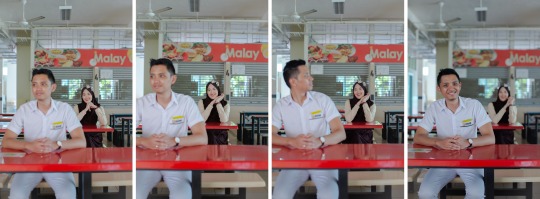





My batch was the first batch of pure science students who were offered D&T as an O’ level subject, hence I took it up and became quite a queen at it. On the contrary, Isk took up F&N while a huge portion of his friends were in D&T. Though his friends and I had different teachers, my portfolio was often used as a teaching tool to set a certain standard for the exam, so it was impossible not to know me. Besides, the D&T block was too small to miss anyone so eventually, we all made friends! They frequently stayed back after school and joined my study sessions at my favourite bench right outside my 4C classroom. Isk joined us once in a while too. A reliable source told me that he even offered to help his friends out in the D&T workshop as an excuse to steal a glance at me 😂 Anyway, since the graduating batch had freezing cold aircon classrooms, Isk borrowed me his oversized Arsenal jacket which I wore during class often. It was then when they found out that Isk and I have been in contact with each other, and although we were nothing more than just friends, they teased us - A LOT.



I guess the endless teasing kinda worked and we slowly begun developing feelings for each other. It was wonderful to have a companion, someone I felt comfortable with and someone whom I can simply share about the happenings of my day. Though it was unsaid, we both knew that we were more than just friends but never really acknowledged it. Even the rumour of us being together got to the staff room and teachers knew about it. And they too, joined in the fun. We had the same English and A Math teacher and since I was the chairperson, they made me carry stacks of worksheets to his class often 😂 They weren’t too heavy and the distance was only two classrooms away okay!
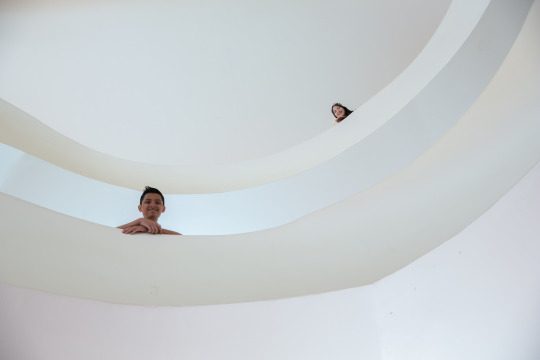

We just went with the flow and we got comfortable around each other so casual texts, eventually became intimate phone calls which involved me falling asleep 99.9% of the time. Our relationship status was clearly more than just friends, but it still remained unknown. Besides, we were too young, too carefree and too busy to really care. Since we were both in our graduating year, dating was entirely out of the question. Besides, I had a tiger mum too! 😜 Back then, the nerd that I was, never really wanted to be in a relationship till I was 20. I thought it was pretty useless to have one at such a young age since we won’t be able to get married anytime soon anyway 😂 Regardless, we remained that status hence we made it a point to revise for O’s together, had meals from the nearby 7-Eleven or at the bubble-tea shop after school but that was basically it. More often than not, it was rarely just the two of us - we were always surrounded by the company of our mutual friends which was actually enjoyable since study sessions became really fun amidst all the exam stress though I was technically the tutor!



Even up till today, he has never asked me to be his girlfriend. When people asked us how it all started, we’ll simply reply “It just happened.” There was no anniversary date so we pretty much made one up and decided that May 2010 was the month we both begun developing feelings for each other 😂 I still cringe at the word ‘girlfriend’ or ‘boyfriend’, so for the past eight years, I’ve never used it. I referred him as a friend often. I guess fiancé became a more comfortable term since we are now engaged since February, but I have only two months left to call him that!


Studying for O’s, we envisioned where we would be in the near future. I was set on going to a JC and he was set on going to a Poly. We knew for sure, that we were going on separate ways, with our own personal goals for the future. We were just kids when we fell in love, not knowing what it was 🎶 But as companions, we were determined to make things work out. On the day of our O’level results, we were both really anxious. We queued at our respective classes and upon receiving our certs, we ran across the hall to look for each other in the crowd. Overall, we both fared well! I even remembered him thanking me for pushing him to study hard for O’s while walking out the school 😂 Eventually as expected, we went to separate ways as I enrolled myself into Anderson JC while he pursued chemical engineering in Singapore Poly.


Eight years passed by in the flash. Many asked us the secret to our long term relationship which never involved breakups or fights in between. For me, I’ve never believed in breaking up over a disagreement. I mean if it was a marriage, would you have asked for a divorce instead? We were young and careless, but we never fail to work things out together. I was determined that I did not need a third parent so I never had to report everything I did to him 😁 We rarely got to meet as my A’level days were such a stressful and busy period for me but when we talked over the phone, we simply casually shared the happenings of our day and constantly rant when times get tough. We always strive to be better for each other, for a comfortable future together. All in all, the key was not to act like a married couple before getting engaged or married. Lead your own life knowing that you have a companion with you and one day when the time is ripe (and when God permits), you’ll eventually be walking on the same path together.

Above a long term relationship, we were faced with a long distance one. It’s yet another chapter with a lengthy post to share, but perhaps done next time instead 😂 It was such a meaningful period for us and the best one yet thus far. After going through it, we came to a realisation that if two hearts are meant to be together, no matter how long it takes, how far they go, how tough it seems, love will bring them together to share their love forever. We came so far, Iskandar. From the wave of emotions to a comfortable silence, I can never ask for better.



The beauty of being childhood friends and high school sweethearts, was that we were able to applaud each other for every milestone we had achieved. From our O’level results, to my A’level one, to his Poly graduation, to my enrolment to uni, to his army enrolment, to the setting up of my business, to his national service parade, to my Maqayla events, to his enrolment to the overseas uni, to my expansion of business, to his graduation, to my awards, to his first job and the list is simply endless. Through thick and thin, laughters and tears, we’ll be summing up our eight-year journey on our wedding day just two months away, surrounded by people we love and people who love us. With that, with sincere hearts, please do keep us in your prayers always ❤️


0 notes
Text
Ripple Effect: 5 Questions With Co-Founder Adam Lowry
Adam Lowry is trying to do for plant-based milks what he already helped do for sustainabe household cleaning products: bring them into the mainstream and consumers’ refrigerators.
As the co-founder and co-CEO of Ripple Foods, whose first product is pea milk (more on that below), Lowry is well on his way. In addition to raising $44 million in funding from Google and Silicon Valley venture capitalists, Ripple’s plant-based milk has generated more than $20 million in revenue since launching in early 2016.
A mainstay in the refrigerated grocery section at Target stores, the next stage is happening now—expanding its product line beyond milk while expanding distribution and brand awareness.
Lowry (right) co-founded Method Home cleaning products, which was generating $100 million in annual sales by 2012, when it was sold to Belgian CPG company Ecover. In addition to a design-led brand that made replacement pouches for its curvy bottles the norm, Method built a factory on Chicago’s South Side to create jobs while adhering to exemplary environmental standards.
Those lessons are with him today as he helps build Ripple. With its clean taste and ample protein—8 grams per serving, the same as dairy milk and comparable to soy milk while higher than almond milk—Ripple is touting a unique value proposition and product offering versus non-dairy milks and over competitive brands. Hence its bold tagline: “Dairy free. As it should be.”
For a start, sustainability is at the heart of the brand. Each 48-ounce bottle of Ripple saves 3.5 pounds of carbon dioxide emissions and 925 gallons of water versus dairy milk, the company says. Getting the same amount of protein from almond milk would require 66 billion additional gallons of agricultural water.
“Plant-based milks are a $2 billion market that’s forecast to go to $4 billion in a short period of time,” Lowry, a climate scientist turned entrepreneur, told brandchannel. “There’s a profound shift going on for a variety of reasons, ranging from health desires to sustainability benefits.”
As for its core ingredient, Ripple protein comes from yellow peas, the same raw material that goes into Hampton Creek’s faux mayonnaise, Just Mayo. Ripple has taken the extra step of concocting a patent-pending process that strips out the flavor of plant material and leaves almost pure protein, so it doesn’t taste like peas. This gives the product the advantage of a neutral taste, unlike soy or almond milks.
Introducing NEW Ripple Greek Yogurt Alternative! With 12g of pure plant-based protein per serving, now you can enjoy all the benefits of greek yogurt without the dairy. Ripple Yogurt is available in five flavors: Original, Vanilla, Strawberry, Blueberry, and Maple. Find it on shelf now at Kroger stores, and many more regional grocers coming soon. Learn more through our link in profile!
A post shared by Ripplefoods (@ripplefoods) on Dec 1, 2017 at 3:05pm PST
//platform.instagram.com/en_US/embeds.js
Ripple is working on making more products from its proprietary protein, which it calls Ripptein, including a Greek yogurt alternative that it launched on December 1st in beta. It’s taking customers’ feedback (and criticisms) on-board, announcing on December 12th on Facebook that it’s still refining the product and looking to make the non-dairy yogurt creamier and more pleasing.
It’s also looking beyond peas for other sources of plant protein which could be derived from the same process and even cost to produce while maintaining a low-impact environmental footprint.
For more insights from the former Method man who’s looking to make a Ripple with nutritional and grocery buying habits, we spoke with Lowry about his second major CPG startup.
Adam, what do you think will be the tipping point for making Ripple and other plant-based milks mainstream?
The way I think is, this is our reason for being. Before Ripple came along, dairy alternatives were really terrible alternatives to dairy. Almond milk is thin and watery and chalky. Same with other milks, and 90% of those that are sold have one-eighth the protein of milk—or less—so they’re missing the enjoyment and the nutritional benefits of milk.
As more mainstream consumers want to drink plant-based, that means more people who don’t have to drink plant-based. What will make it go mainstream is to have a dairy alternative that can stand up to dairy milk in terms of taste and nutrition, and that’s what we’re trying to create. Ripple’s got the same protein level as milk and is creamy and delicious.
Is “pea milk” a hard sell, especially as people might assume it tastes like peas?
Yes, you can say “pea milk” and people kind of chuckle. But at the end of the day, it hasn’t been a huge barrier for us. We’re the first people to make a milk from peas. You want to be 100% transparent about what the milk is made from because that’s the first thing people want to know.
The brand architecture we use, what we really talk about, is Ripptein, and being the purest plant protein on earth. What that’s meant to do is help people understand that what makes Ripple unique is Ripptein, and that comes from peas, but it’s not peas themselves that make Ripple unique. In the future, that might come from something else.
How are you marketing Ripple? Is it all digital/social?
A lot of our marketing, nearly all of it, is digital in nature. That’s a function of who we’re talking to. The average age of a Ripple consumer is 33, much younger than the average age of other brands and consumers in the space. These are people who consume digital media primarily. We are doing a little bit of traditional media on top of that—a broad awareness play, region by region—as we build out our distribution.
And much like my previous business, Method, what we really rely on is storytelling. The media we earn (is) by having a really distinctive product proposition and an interesting brand where there aren’t really a lot of interesting brands and products. It’s supported by our own social media efforts, but we don’t have as many followers as Ellen [DeGeneres] yet. But we’re building that.
You’ve got an unusual logo—with fading letters—and brand name. What can you share about Ripple’s identity?
It’s about the little things we do each day and those adding up to major acts—about ripples, if you will. If you think about other brands in this space, it’s all about the ingredients they came from. The second-biggest brand in the space is Almond Breeze, and it’s clearly about almonds.
The biggest brand is Silk, a contraction of “soy” and “milk.” Ingredients go in and out of fashion, and almond nuts are a terrible thing to make milk out of—it doesn’t have any protein, isn’t any good, and uses insane amounts of water. Cashew milk is even worse. Coconut milk is terrible from that respect; it has no protein at all.
You don’t want to build a brand around a single ingredient because that’s not a very distinctive or enduring brand proposition. We want Ripple to be a brand across the whole non-dairy space that is one way that you create a little ripple effect in your life.
As for the branding, we wanted to create a logo treatment that’s visually interesting. Brand logo treatments have gotten too similar-looking: modern, lower-case approachable things. The Method logo treatment is a lot like that. But we really wanted something more distinctive. So the big innovation there was to create our own font that we thought not only was distinctive but also a visual reminder of what Ripple the word and brand represent, with the swirliness of the font.
Ripple is built on the truth that the smallest actions can have far reaching impacts. We wrote a letter to you, our fans, to show you how impactful you have been in bringing our mission to life. You have created a wave of change simply by choosing Ripple over something else. Click the link in our profile to see why. #RippleEffect
A post shared by Ripplefoods (@ripplefoods) on Oct 12, 2017 at 11:21am PDT
//platform.instagram.com/en_US/embeds.js
How does sustainability inspire and define what you call the Ripple Effect?
I used to be a climate scientist and I went straight out of college wanting to dedicate my career to environmental issues. I worked on the Kyoto Protocol of 1997, for instance. My frustrations there led me to create my first business, Method. The frustrations were feeling like I was preaching to the converted in my science job. The science was really clear but wasn’t leading to policy change, and still isn’t.
Second, realizing as a green consumer at the time, I was always frustrated because all the products frankly sucked. There were sacrifices: they were brown and ugly and too expensive and you had to go to a different store to buy them and they didn’t work.
That was the original idea behind Method: using business to create social and environmental good. We kind of turned the whole green product model on its head. We created a better product and put it in mainstream stores. That’s exactly what we’re doing with Ripple—and it’s also the most sustainable.
Get more insights in our Q&A series.
Subscribe to our free newsletter for more.
The post Ripple Effect: 5 Questions With Co-Founder Adam Lowry appeared first on brandchannel:.
from WordPress https://glenmenlow.wordpress.com/2017/12/22/ripple-effect-5-questions-with-co-founder-adam-lowry/
via IFTTT
0 notes
Text
Ripple Effect: 5 Questions With Co-Founder Adam Lowry
Adam Lowry is trying to do for plant-based milks what he already helped do for sustainabe household cleaning products: bring them into the mainstream and consumers’ refrigerators.
As the co-founder and co-CEO of Ripple Foods, whose first product is pea milk (more on that below), Lowry is well on his way. In addition to raising $44 million in funding from Google and Silicon Valley venture capitalists, Ripple’s plant-based milk has generated more than $20 million in revenue since launching in early 2016.
A mainstay in the refrigerated grocery section at Target stores, the next stage is happening now—expanding its product line beyond milk while expanding distribution and brand awareness.
Lowry (right) co-founded Method Home cleaning products, which was generating $100 million in annual sales by 2012, when it was sold to Belgian CPG company Ecover. In addition to a design-led brand that made replacement pouches for its curvy bottles the norm, Method built a factory on Chicago’s South Side to create jobs while adhering to exemplary environmental standards.
Those lessons are with him today as he helps build Ripple. With its clean taste and ample protein—8 grams per serving, the same as dairy milk and comparable to soy milk while higher than almond milk—Ripple is touting a unique value proposition and product offering versus non-dairy milks and over competitive brands. Hence its bold tagline: “Dairy free. As it should be.”
For a start, sustainability is at the heart of the brand. Each 48-ounce bottle of Ripple saves 3.5 pounds of carbon dioxide emissions and 925 gallons of water versus dairy milk, the company says. Getting the same amount of protein from almond milk would require 66 billion additional gallons of agricultural water.
“Plant-based milks are a $2 billion market that’s forecast to go to $4 billion in a short period of time,” Lowry, a climate scientist turned entrepreneur, told brandchannel. “There’s a profound shift going on for a variety of reasons, ranging from health desires to sustainability benefits.”
As for its core ingredient, Ripple protein comes from yellow peas, the same raw material that goes into Hampton Creek’s faux mayonnaise, Just Mayo. Ripple has taken the extra step of concocting a patent-pending process that strips out the flavor of plant material and leaves almost pure protein, so it doesn’t taste like peas. This gives the product the advantage of a neutral taste, unlike soy or almond milks.
Introducing NEW Ripple Greek Yogurt Alternative! With 12g of pure plant-based protein per serving, now you can enjoy all the benefits of greek yogurt without the dairy. Ripple Yogurt is available in five flavors: Original, Vanilla, Strawberry, Blueberry, and Maple. Find it on shelf now at Kroger stores, and many more regional grocers coming soon. Learn more through our link in profile!
A post shared by Ripplefoods (@ripplefoods) on Dec 1, 2017 at 3:05pm PST
Ripple is working on making more products from its proprietary protein, which it calls Ripptein, including a Greek yogurt alternative that it launched on December 1st in beta. It’s taking customers’ feedback (and criticisms) on-board, announcing on December 12th on Facebook that it’s still refining the product and looking to make the non-dairy yogurt creamier and more pleasing.
It’s also looking beyond peas for other sources of plant protein which could be derived from the same process and even cost to produce while maintaining a low-impact environmental footprint.
For more insights from the former Method man who’s looking to make a Ripple with nutritional and grocery buying habits, we spoke with Lowry about his second major CPG startup.
Adam, what do you think will be the tipping point for making Ripple and other plant-based milks mainstream?
The way I think is, this is our reason for being. Before Ripple came along, dairy alternatives were really terrible alternatives to dairy. Almond milk is thin and watery and chalky. Same with other milks, and 90% of those that are sold have one-eighth the protein of milk—or less—so they’re missing the enjoyment and the nutritional benefits of milk.
As more mainstream consumers want to drink plant-based, that means more people who don’t have to drink plant-based. What will make it go mainstream is to have a dairy alternative that can stand up to dairy milk in terms of taste and nutrition, and that’s what we’re trying to create. Ripple’s got the same protein level as milk and is creamy and delicious.
Is “pea milk” a hard sell, especially as people might assume it tastes like peas?
Yes, you can say “pea milk” and people kind of chuckle. But at the end of the day, it hasn’t been a huge barrier for us. We’re the first people to make a milk from peas. You want to be 100% transparent about what the milk is made from because that’s the first thing people want to know.
The brand architecture we use, what we really talk about, is Ripptein, and being the purest plant protein on earth. What that’s meant to do is help people understand that what makes Ripple unique is Ripptein, and that comes from peas, but it’s not peas themselves that make Ripple unique. In the future, that might come from something else.
How are you marketing Ripple? Is it all digital/social?
A lot of our marketing, nearly all of it, is digital in nature. That’s a function of who we’re talking to. The average age of a Ripple consumer is 33, much younger than the average age of other brands and consumers in the space. These are people who consume digital media primarily. We are doing a little bit of traditional media on top of that—a broad awareness play, region by region—as we build out our distribution.
And much like my previous business, Method, what we really rely on is storytelling. The media we earn (is) by having a really distinctive product proposition and an interesting brand where there aren’t really a lot of interesting brands and products. It’s supported by our own social media efforts, but we don’t have as many followers as Ellen [DeGeneres] yet. But we’re building that.
You’ve got an unusual logo—with fading letters—and brand name. What can you share about Ripple’s identity?
It’s about the little things we do each day and those adding up to major acts—about ripples, if you will. If you think about other brands in this space, it’s all about the ingredients they came from. The second-biggest brand in the space is Almond Breeze, and it’s clearly about almonds.
The biggest brand is Silk, a contraction of “soy” and “milk.” Ingredients go in and out of fashion, and almond nuts are a terrible thing to make milk out of—it doesn’t have any protein, isn’t any good, and uses insane amounts of water. Cashew milk is even worse. Coconut milk is terrible from that respect; it has no protein at all.
You don’t want to build a brand around a single ingredient because that’s not a very distinctive or enduring brand proposition. We want Ripple to be a brand across the whole non-dairy space that is one way that you create a little ripple effect in your life.
As for the branding, we wanted to create a logo treatment that’s visually interesting. Brand logo treatments have gotten too similar-looking: modern, lower-case approachable things. The Method logo treatment is a lot like that. But we really wanted something more distinctive. So the big innovation there was to create our own font that we thought not only was distinctive but also a visual reminder of what Ripple the word and brand represent, with the swirliness of the font.
Ripple is built on the truth that the smallest actions can have far reaching impacts. We wrote a letter to you, our fans, to show you how impactful you have been in bringing our mission to life. You have created a wave of change simply by choosing Ripple over something else. Click the link in our profile to see why. #RippleEffect
A post shared by Ripplefoods (@ripplefoods) on Oct 12, 2017 at 11:21am PDT
How does sustainability inspire and define what you call the Ripple Effect?
I used to be a climate scientist and I went straight out of college wanting to dedicate my career to environmental issues. I worked on the Kyoto Protocol of 1997, for instance. My frustrations there led me to create my first business, Method. The frustrations were feeling like I was preaching to the converted in my science job. The science was really clear but wasn’t leading to policy change, and still isn’t.
Second, realizing as a green consumer at the time, I was always frustrated because all the products frankly sucked. There were sacrifices: they were brown and ugly and too expensive and you had to go to a different store to buy them and they didn’t work.
That was the original idea behind Method: using business to create social and environmental good. We kind of turned the whole green product model on its head. We created a better product and put it in mainstream stores. That’s exactly what we’re doing with Ripple—and it’s also the most sustainable.
Get more insights in our Q&A series.
Subscribe to our free newsletter for more.
The post Ripple Effect: 5 Questions With Co-Founder Adam Lowry appeared first on brandchannel:.
0 notes
Text
Ripple Effect: 5 Questions With Co-Founder Adam Lowry
Adam Lowry is trying to do for plant-based milks what he already helped do for sustainabe household cleaning products: bring them into the mainstream and consumers’ refrigerators.
As the co-founder and co-CEO of Ripple Foods, whose first product is pea milk (more on that below), Lowry is well on his way. In addition to raising $44 million in funding from Google and Silicon Valley venture capitalists, Ripple’s plant-based milk has generated more than $20 million in revenue since launching in early 2016.
A mainstay in the refrigerated grocery section at Target stores, the next stage is happening now—expanding its product line beyond milk while expanding distribution and brand awareness.
Lowry (right) co-founded Method Home cleaning products, which was generating $100 million in annual sales by 2012, when it was sold to Belgian CPG company Ecover. In addition to a design-led brand that made replacement pouches for its curvy bottles the norm, Method built a factory on Chicago’s South Side to create jobs while adhering to exemplary environmental standards.
Those lessons are with him today as he helps build Ripple. With its clean taste and ample protein—8 grams per serving, the same as dairy milk and comparable to soy milk while higher than almond milk—Ripple is touting a unique value proposition and product offering versus non-dairy milks and over competitive brands. Hence its bold tagline: “Dairy free. As it should be.”
For a start, sustainability is at the heart of the brand. Each 48-ounce bottle of Ripple saves 3.5 pounds of carbon dioxide emissions and 925 gallons of water versus dairy milk, the company says. Getting the same amount of protein from almond milk would require 66 billion additional gallons of agricultural water.
“Plant-based milks are a $2 billion market that’s forecast to go to $4 billion in a short period of time,” Lowry, a climate scientist turned entrepreneur, told brandchannel. “There’s a profound shift going on for a variety of reasons, ranging from health desires to sustainability benefits.”
As for its core ingredient, Ripple protein comes from yellow peas, the same raw material that goes into Hampton Creek’s faux mayonnaise, Just Mayo. Ripple has taken the extra step of concocting a patent-pending process that strips out the flavor of plant material and leaves almost pure protein, so it doesn’t taste like peas. This gives the product the advantage of a neutral taste, unlike soy or almond milks.
Introducing NEW Ripple Greek Yogurt Alternative! With 12g of pure plant-based protein per serving, now you can enjoy all the benefits of greek yogurt without the dairy. Ripple Yogurt is available in five flavors: Original, Vanilla, Strawberry, Blueberry, and Maple. Find it on shelf now at Kroger stores, and many more regional grocers coming soon. Learn more through our link in profile!
A post shared by Ripplefoods (@ripplefoods) on Dec 1, 2017 at 3:05pm PST
Ripple is working on making more products from its proprietary protein, which it calls Ripptein, including a Greek yogurt alternative that it launched on December 1st in beta. It’s taking customers’ feedback (and criticisms) on-board, announcing on December 12th on Facebook that it’s still refining the product and looking to make the non-dairy yogurt creamier and more pleasing.
It’s also looking beyond peas for other sources of plant protein which could be derived from the same process and even cost to produce while maintaining a low-impact environmental footprint.
For more insights from the former Method man who’s looking to make a Ripple with nutritional and grocery buying habits, we spoke with Lowry about his second major CPG startup.
Adam, what do you think will be the tipping point for making Ripple and other plant-based milks mainstream?
The way I think is, this is our reason for being. Before Ripple came along, dairy alternatives were really terrible alternatives to dairy. Almond milk is thin and watery and chalky. Same with other milks, and 90% of those that are sold have one-eighth the protein of milk—or less—so they’re missing the enjoyment and the nutritional benefits of milk.
As more mainstream consumers want to drink plant-based, that means more people who don’t have to drink plant-based. What will make it go mainstream is to have a dairy alternative that can stand up to dairy milk in terms of taste and nutrition, and that’s what we’re trying to create. Ripple’s got the same protein level as milk and is creamy and delicious.
Is “pea milk” a hard sell, especially as people might assume it tastes like peas?
Yes, you can say “pea milk” and people kind of chuckle. But at the end of the day, it hasn’t been a huge barrier for us. We’re the first people to make a milk from peas. You want to be 100% transparent about what the milk is made from because that’s the first thing people want to know.
The brand architecture we use, what we really talk about, is Ripptein, and being the purest plant protein on earth. What that’s meant to do is help people understand that what makes Ripple unique is Ripptein, and that comes from peas, but it’s not peas themselves that make Ripple unique. In the future, that might come from something else.
How are you marketing Ripple? Is it all digital/social?
A lot of our marketing, nearly all of it, is digital in nature. That’s a function of who we’re talking to. The average age of a Ripple consumer is 33, much younger than the average age of other brands and consumers in the space. These are people who consume digital media primarily. We are doing a little bit of traditional media on top of that—a broad awareness play, region by region—as we build out our distribution.
And much like my previous business, Method, what we really rely on is storytelling. The media we earn (is) by having a really distinctive product proposition and an interesting brand where there aren’t really a lot of interesting brands and products. It’s supported by our own social media efforts, but we don’t have as many followers as Ellen [DeGeneres] yet. But we’re building that.
You’ve got an unusual logo—with fading letters—and brand name. What can you share about Ripple’s identity?
It’s about the little things we do each day and those adding up to major acts—about ripples, if you will. If you think about other brands in this space, it’s all about the ingredients they came from. The second-biggest brand in the space is Almond Breeze, and it’s clearly about almonds.
The biggest brand is Silk, a contraction of “soy” and “milk.” Ingredients go in and out of fashion, and almond nuts are a terrible thing to make milk out of—it doesn’t have any protein, isn’t any good, and uses insane amounts of water. Cashew milk is even worse. Coconut milk is terrible from that respect; it has no protein at all.
You don’t want to build a brand around a single ingredient because that’s not a very distinctive or enduring brand proposition. We want Ripple to be a brand across the whole non-dairy space that is one way that you create a little ripple effect in your life.
As for the branding, we wanted to create a logo treatment that’s visually interesting. Brand logo treatments have gotten too similar-looking: modern, lower-case approachable things. The Method logo treatment is a lot like that. But we really wanted something more distinctive. So the big innovation there was to create our own font that we thought not only was distinctive but also a visual reminder of what Ripple the word and brand represent, with the swirliness of the font.
Ripple is built on the truth that the smallest actions can have far reaching impacts. We wrote a letter to you, our fans, to show you how impactful you have been in bringing our mission to life. You have created a wave of change simply by choosing Ripple over something else. Click the link in our profile to see why. #RippleEffect
A post shared by Ripplefoods (@ripplefoods) on Oct 12, 2017 at 11:21am PDT
How does sustainability inspire and define what you call the Ripple Effect?
I used to be a climate scientist and I went straight out of college wanting to dedicate my career to environmental issues. I worked on the Kyoto Protocol of 1997, for instance. My frustrations there led me to create my first business, Method. The frustrations were feeling like I was preaching to the converted in my science job. The science was really clear but wasn’t leading to policy change, and still isn’t.
Second, realizing as a green consumer at the time, I was always frustrated because all the products frankly sucked. There were sacrifices: they were brown and ugly and too expensive and you had to go to a different store to buy them and they didn’t work.
That was the original idea behind Method: using business to create social and environmental good. We kind of turned the whole green product model on its head. We created a better product and put it in mainstream stores. That’s exactly what we’re doing with Ripple—and it’s also the most sustainable.
Get more insights in our Q&A series.
Subscribe to our free newsletter for more.
The post Ripple Effect: 5 Questions With Co-Founder Adam Lowry appeared first on brandchannel:.
0 notes